Montana’s birdlife takes readers on a colorful exploration of nature. The state’s wide variety of habitats creates a lively environment for both native and migratory birds, making Montana a top destination for bird enthusiasts and researchers alike.
Montana is a birdwatcher’s paradise with diverse landscapes offering homes to 433 bird species, each bird adding another layer of beauty to the state’s wildlife.
From the Bald Eagles soaring over the forested areas to the Western Bluebirds perched atop fences, we’ll cover the top 37 birds you’ll find in Montana. This guide not only introduces these birds but also provides insights into their behaviors, habitats, and importance to the local ecosystem.
- Related article: Observing Wildlife in Montana
Uncover the secrets of Montana’s skies and forests as we shed light on the captivating world of its bird residents. Join us as we dive into the lives of the feathered creatures that call Montana home, drawing you into their world.
7 Key Takeaways on Montana Birds
- The most common species of birds in Montana include the American Coot, a distinctive black bird that often nests in marshy areas and gathers in large groups.
- The American Crow, known for its intelligence and unique flying style, thrives in various habitats, from woodlands to urban landscapes, making it a delightful birdwatching subject.
- With its bright yellow coloring and social nature, the American Goldfinch is an easily spotted species in Montana’s open areas. It is known for its distinct “potato chip” call.
- American Robins announce spring’s arrival with their cheery songs and earthworm-hunting technique. They are a part of the thrush family and are most commonly found in lawns and gardens.
- The Bald Eagle, a majestic bird that symbolizes American patriotism, can primarily be seen near water sources in forested areas, often thriving alongside other species.
- The Black-billed Magpie is a common species sighted in western North America and plays a unique role in the ecosystem by aiding large mammals in grooming.
- The Black-capped Chickadee is easily recognizable by its curious nature. Its unique vocalizations and foraging habits make it an engaging subject for birdwatchers in forests.
Common Montana Birds
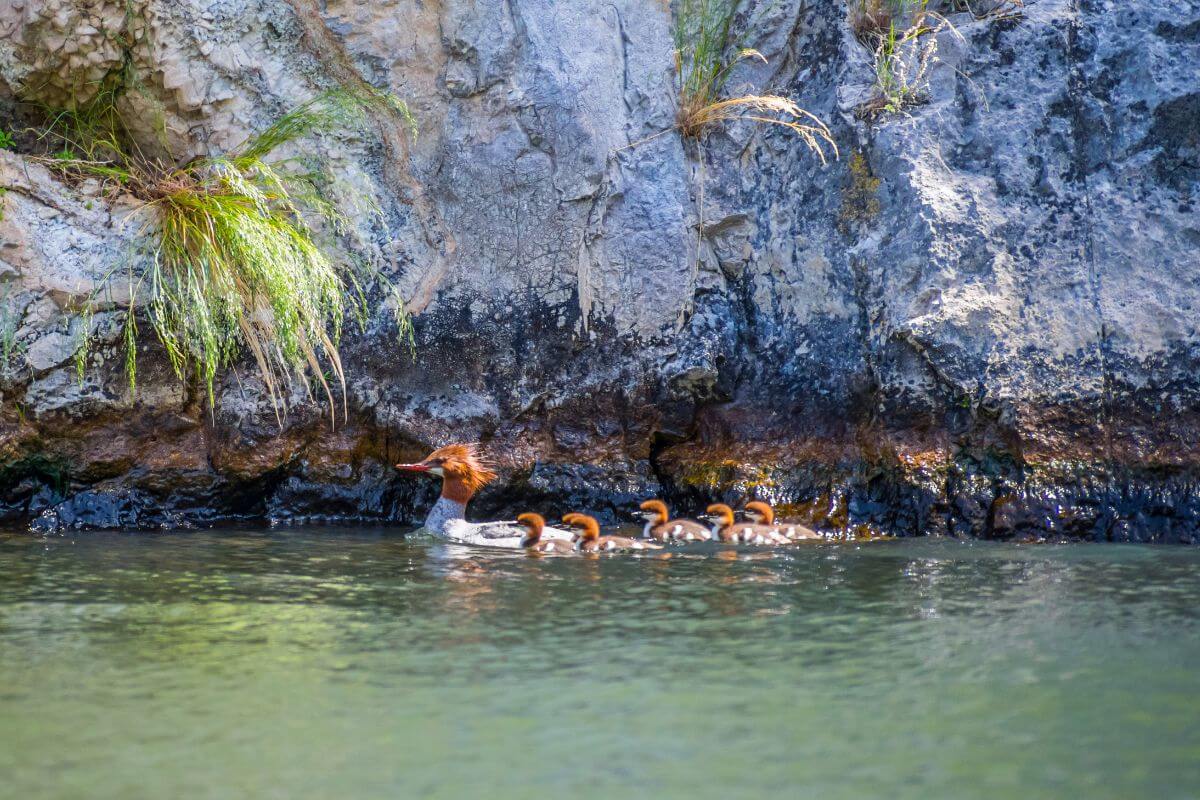
Montana’s skies are full of life with a variety of birds, making birdwatching a delightful experience for nature lovers. Whether you’re exploring the open forests, vast grasslands, or shimmering waterways, these common birds are sure to brighten your day.
These common Montana birds are often seen anywhere, right in your backyard or local parks. Enjoying their beauty and songs can be a peaceful and educational pastime for birdwatchers of all ages and expertise levels. Get your binoculars ready, because these birds are waiting to be discovered.
1. American Coot
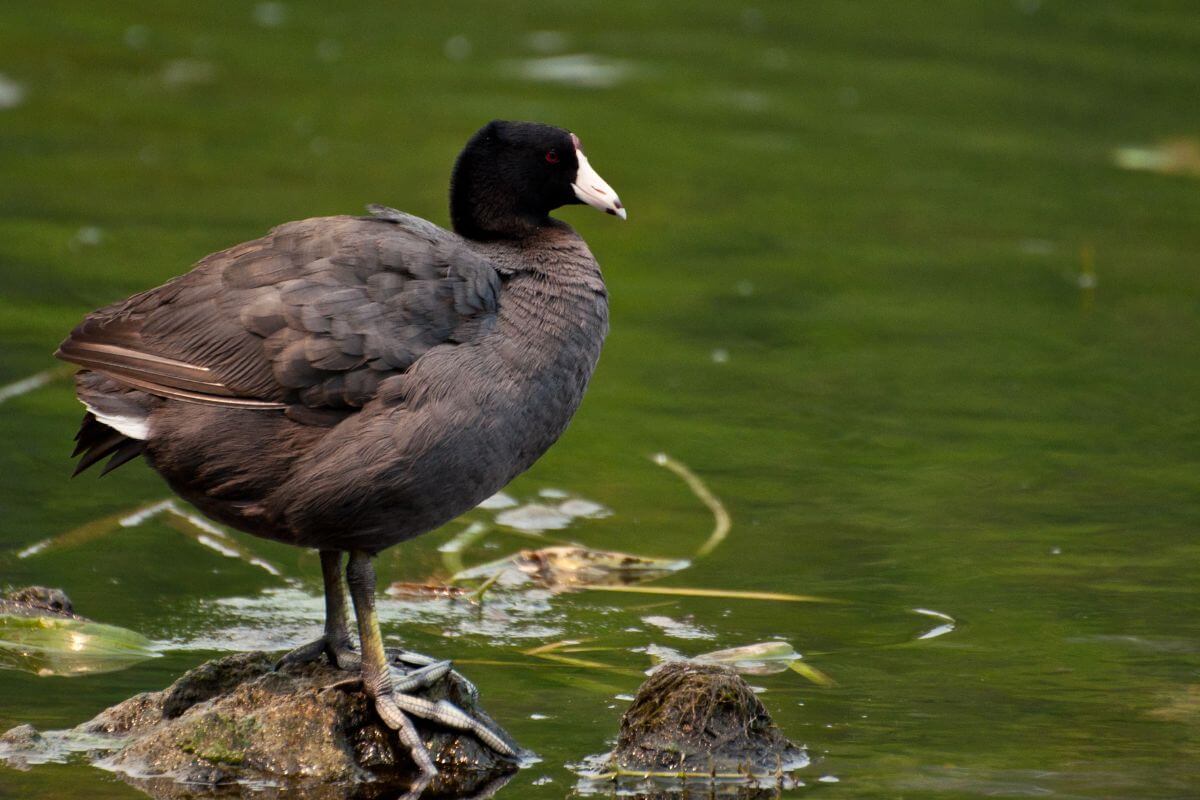
| Key Characteristic | Details |
|---|---|
| Scientific Name | Fulica americana |
| Family | Rallidae (Rails) |
| Habitat | Lakes and ponds |
| Food | Grains, grasses, and agricultural crops on land |
| Color | Dark-gray to black |
The American Coot is a key player in Montana’s birdwatching scene. As you scan the state’s pristine lakes and ponds, you might spot this blackish bird with a distinct chalky white beak and striking reddish eyes.
Here’s what makes American Coot spotting an exciting find:
- American Coot are easily spotted with their dark gray to black bodies and bright white bills.
- An interesting fact about the American Coot is that it makes nests from aquatic plants floating in marshy areas.
- American Coots don’t have webbed feet like ducks, even though they swim like them.
- During winter, American Coots like to hang out in large numbers with other waterfowl. Sometimes, they can be found in groups of several thousand.
The American Coot offers a great starting point if you’re a beginner birder. It is known for its prevalence and easy-to-spot features. So, next time you’re out enjoying Montana’s water bodies, watch for these fascinating creatures, which blend in with the more commonly seen ducks.
2. American Crow
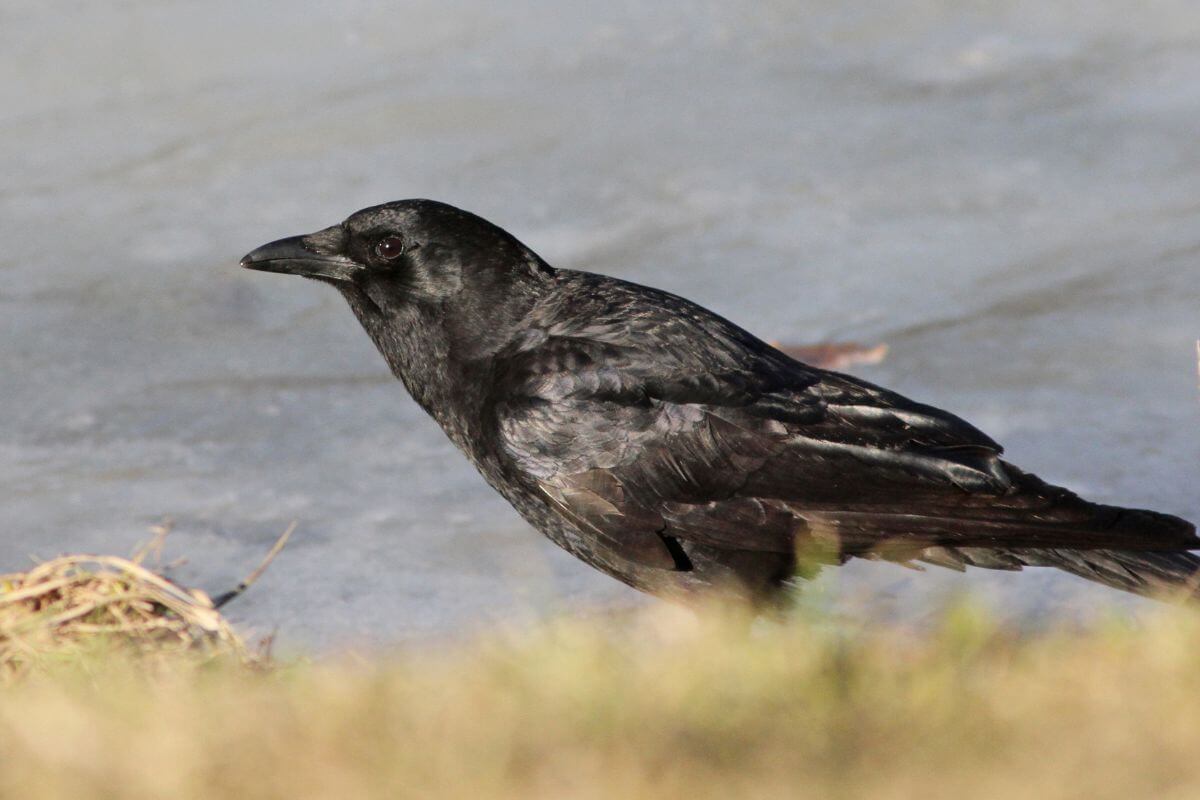
| Key Characteristic | Details |
|---|---|
| Scientific Name | Corvus brachyrhynchos |
| Family | Corvidae (Jays/Crows/Magpies) |
| Habitat | Open Woodlands |
| Food | Seeds, insects, and small snakes |
| Color | All black |
The American Crow is a bird you’re sure to encounter. These large, smart, and all-black birds are known across a vast range for their distinguishable caws. They thrive in various habitats, from woodlands to urban landscapes like parks, fields, and parking lots.
Here are some quick facts about American Crows to make you stand out at the bird-watching party:
- This American Crow’s flying style is distinctive. It flaps its wings methodically, rarely broken up with glides.
- Young American Crows take their time to settle down. Breeding typically begins after at least two years, sometimes not until they are four or older.
- American Crows can lead a ‘two lives’ kind of day, splitting their time between town and open fields where they look for food with their mates.
- American Crows are curious birds with a mischievous streak. They’re also good at solving problems and learning new things. They often search garbage cans and containers for food scraps to eat.
- American Crows build bulky stick nests, perched high in trees. They’re adaptable and comfortable in most habitats except high mountains and deserts.
Watching these birds can be a lesson in survival and adaptability. Look for them in your nearest wooded area or even the city park. With their loud cawing, you might spot them hanging around garbage dumps or family picnics.
3. American Goldfinch
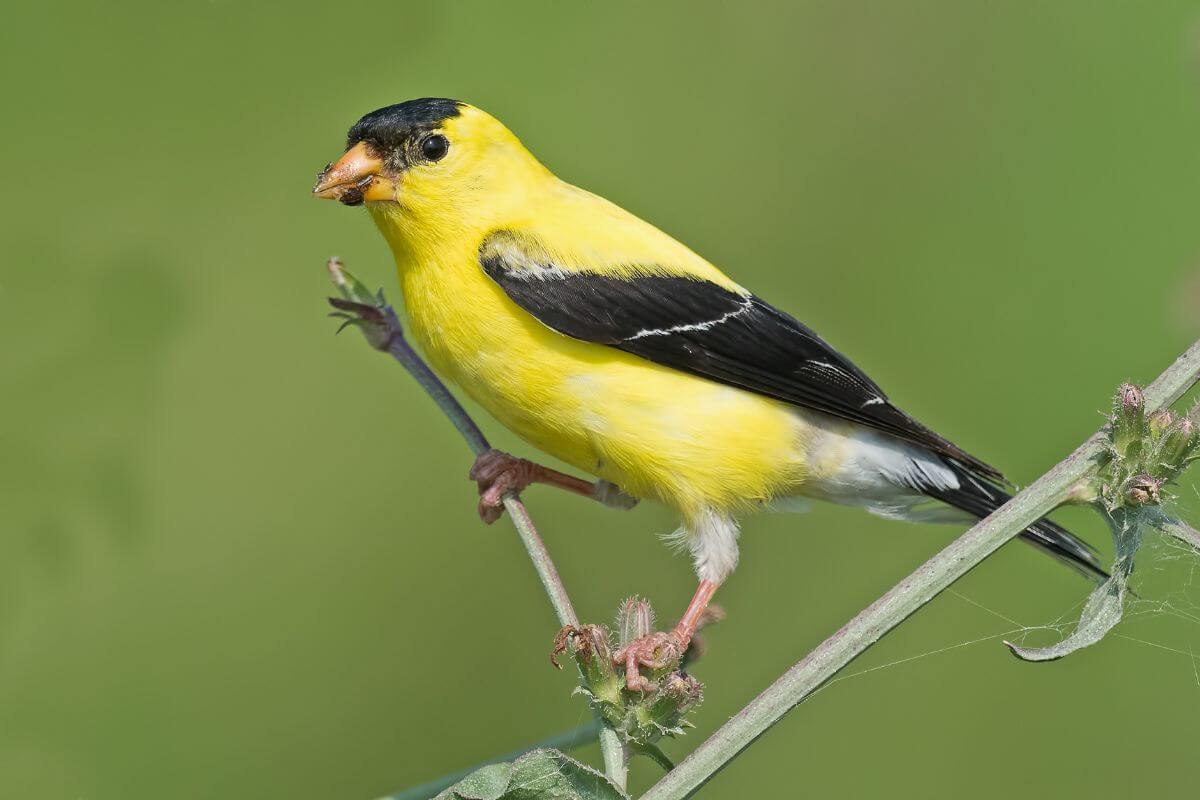
| Key Characteristic | Details |
|---|---|
| Scientific Name | Spinus tristis |
| Family | Fringillidae (Finches) |
| Habitat | Open woodlands |
| Food | Seeds |
| Color | Bright and duller yellow |
The American Goldfinch is a delightful small finch with short, conical bill, small head, long wings, and short, notched tail. You can spot them on open woodlands, standing out with their bright and dull yellow coloring.
Here are some interesting facts about the American Goldfinch:
- American Goldfinches are super picky eaters, staying true to a vegetarian diet and only occasionally munching on insects by mistake.
- Often described as “potato chip,” the American Goldfinch’s flight call indicates its presence in open areas.
- Paired-up goldfinches have almost identical calls, allowing them to recognize one another in a crowd.
- During the summer, the male American Goldfinches showcase a vibrant lemon yellow color with a small black cap, a light-colored beak, and some white patterns on their long black wings.
Watch for this social species if you’re out birdwatching during the day. They often enjoy their meals in groups and are relatively easy to find in North America, excluding dense forests. Look out for their sunny plumage and listen for their distinctive calls as they dart through the sky in their playful way.
4. American Robin
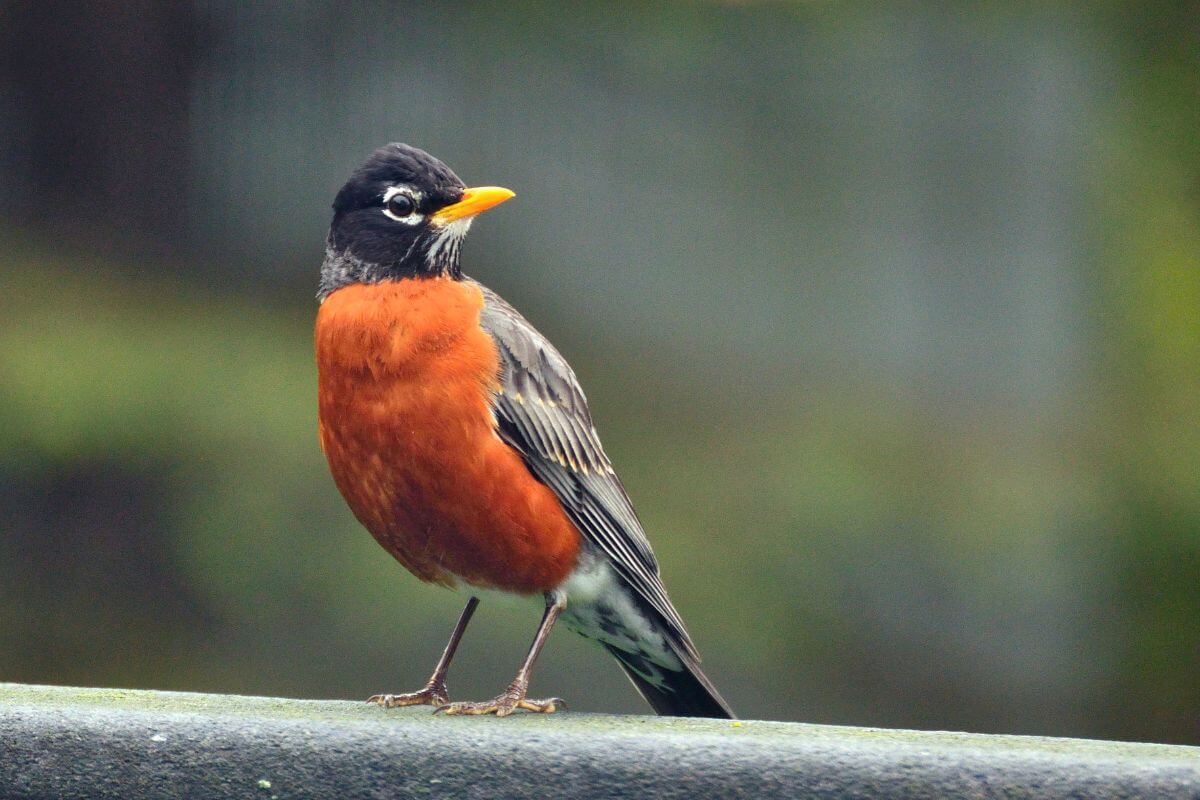
| Key Characteristic | Details |
|---|---|
| Scientific Name | Turdus migratorius |
| Family | Turdidae (Thrushes) |
| Habitat | Forest, woodland, and gardens |
| Food | Invertebrates and fruit |
| Color | Gray-brown birds |
American Robins are the quintessential early birds that grace lawns across Montana and North America. You’ve probably witnessed their unique technique of pulling earthworms from the earth. Robins are beloved birds known for their bright orange breasts, cheerful song, and early arrival in springtime.
Here’s what you need to know about American Robin:
- Where to Find Them – Robins are commonly spotted on lawns or gardens, particularly during the early hours of the day. You might see them searching for breakfast or singing from a high perch.
- Identifying Features – American Robins are large songbirds with round bodies, long legs, and fairly long tails. They are the largest North American thrushes.
- Interesting Tidbit – Robins switch their diet seasonally, feasting on invertebrates and fruit, including honeysuckle berries. Interestingly, a diet heavy in these berries can occasionally lead to a tipsy robin!
- Nesting and Habits – American Robins are skilled nest builders, crafting cup-shaped homes in trees. They’re familiar with forests, woodlands, parks, and residential areas.
To spot American Robins, keep an ear out for their melodious call that pierces the early morning quiet. Their distinctive song often leads bird enthusiasts to seek them out. These common thrushes are more than just early-morning visitors — they are the opening tune in nature’s great spring symphony.
5. Bald Eagle
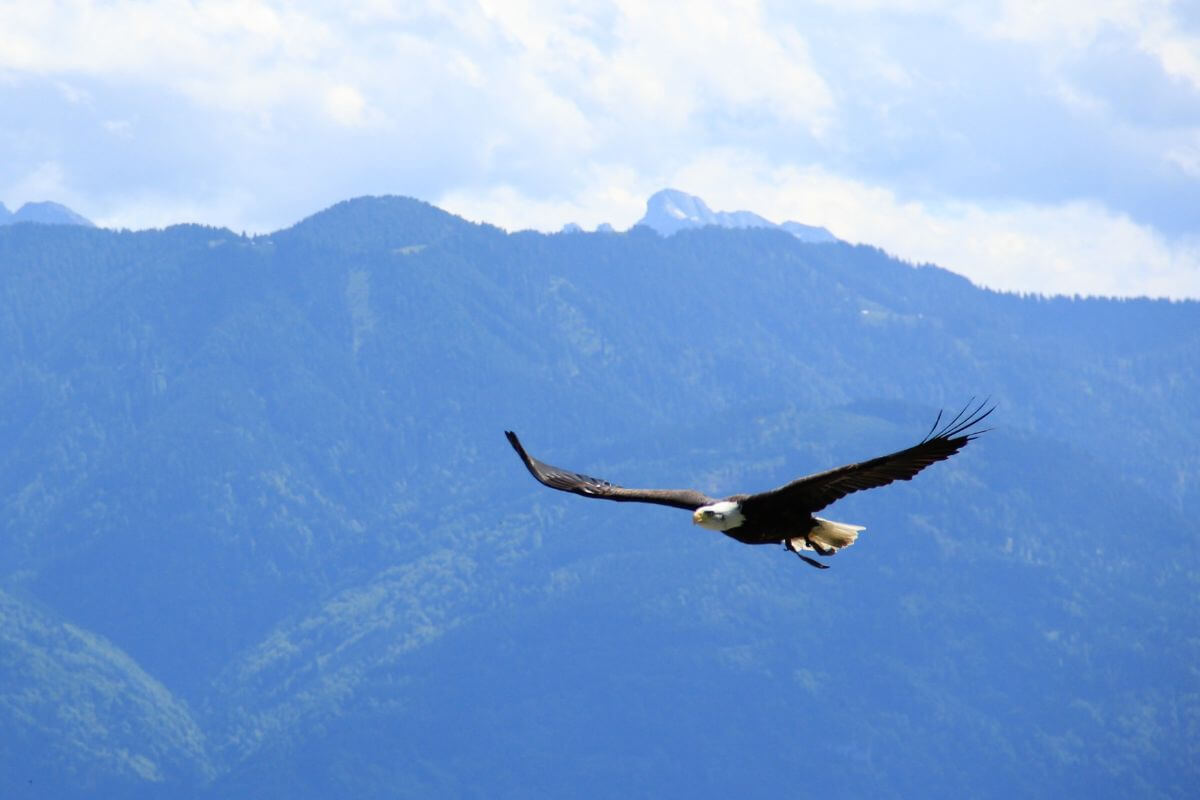
| Key Characteristic | Details |
|---|---|
| Scientific Name | Haliaeetus leucocephalus |
| Family | Accipitridae (Hawks/Kites/Eagles) |
| Habitat | Forested areas along rivers and lakes |
| Food | Fish |
| Color | White heads and tails with dark brown bodies and wings |
The Bald Eagle is a majestic bird that stands as a symbol of American patriotism and native spirituality. These birds are striking, with their white heads and tails against dark brown bodies and wings.
Here are some fascinating facts about the Bald Eagle:
- Instead of fishing for themselves, Bald Eagles often take advantage of other animals’ catches.
- In a historical twist, the national emblem of the United States could have been the Wild Turkey, as Benjamin Franklin criticized the Bald Eagle for its scavenging habits back in 1784.
- Bald Eagles have impressive longevity, with the oldest known wild Bald Eagle living at least 38 years.
- Often portrayed as strong and commanding, Bald Eagle vocalizations are a series of weak chirps.
If you’re looking to glimpse these awe-inspiring creatures, remember to check near water bodies where they are most likely to be found.
6. Black-Billed Magpie
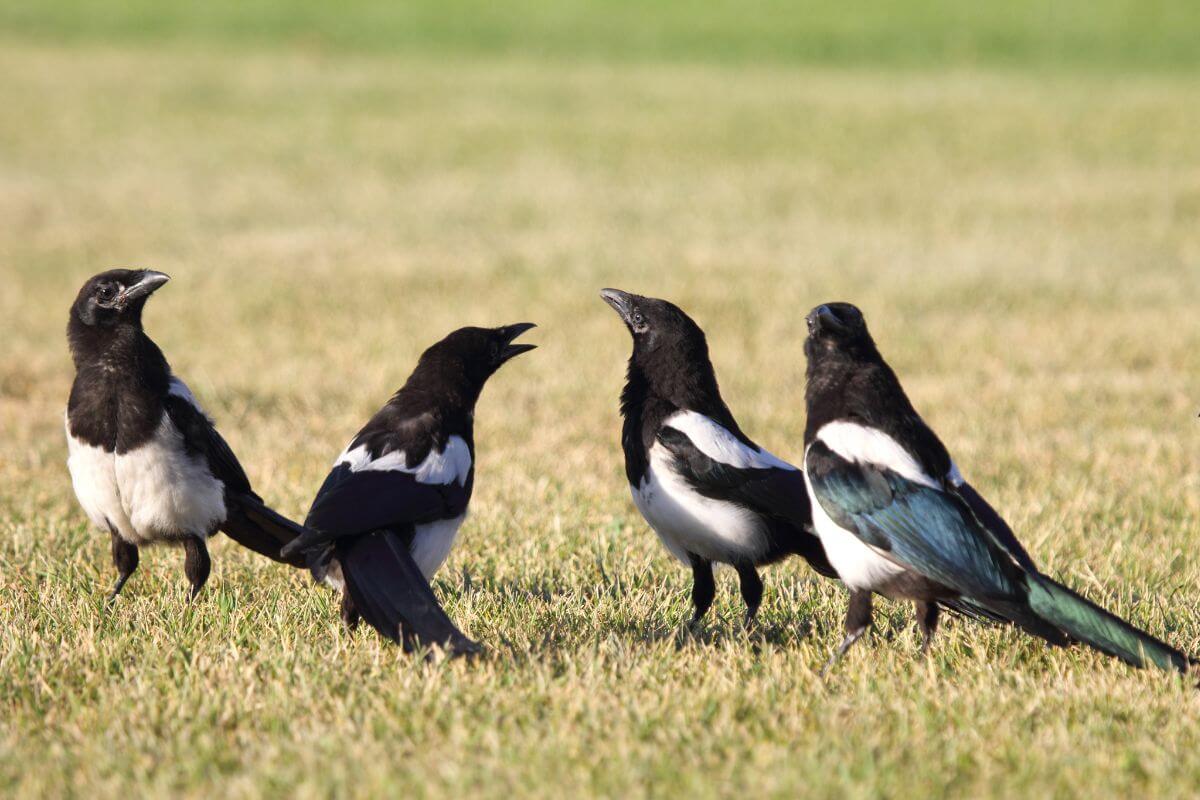
| Key Characteristic | Details |
|---|---|
| Scientific Name | Pica hudsonia |
| Family | Corvidae (Jays/Crows/Magpies) |
| Habitat | Open meadows, grasslands, or sagebrush |
| Food | Ground-dwelling arthropods, seeds, and carrion |
| Color | Black and white overall |
The Black-billed magpie is a bird known for its familiar and entertaining presence across western North America. These magpies are common in open meadows, grasslands, and sagebrush. Their black and white plumage makes them stand out amid natural landscapes.
Here are a few fascinating facts about the Black-billed Magpie:
- The Black-billed magpie builds an impressive nest, taking up to 40 days to finish. It’s one of the biggest and most impressive nests among birds.
- Black-billed magpies have had a deep and complex connection with humans for centuries based on historical accounts from the American West. This shows their adaptability and intelligence.
- Black-billed magpies play a unique role in the ecosystem by helping large mammals like deer and moose groom. They frequently remove ticks and other pests from their backs, contributing to the overall health of the wildlife community.
These birds are eye-catching and vocal, filling the air with raucous calls. You’ll often find them perched high on trees or fenceposts, allowing you to spot and hear them easily.
7. Black-Capped Chickadee
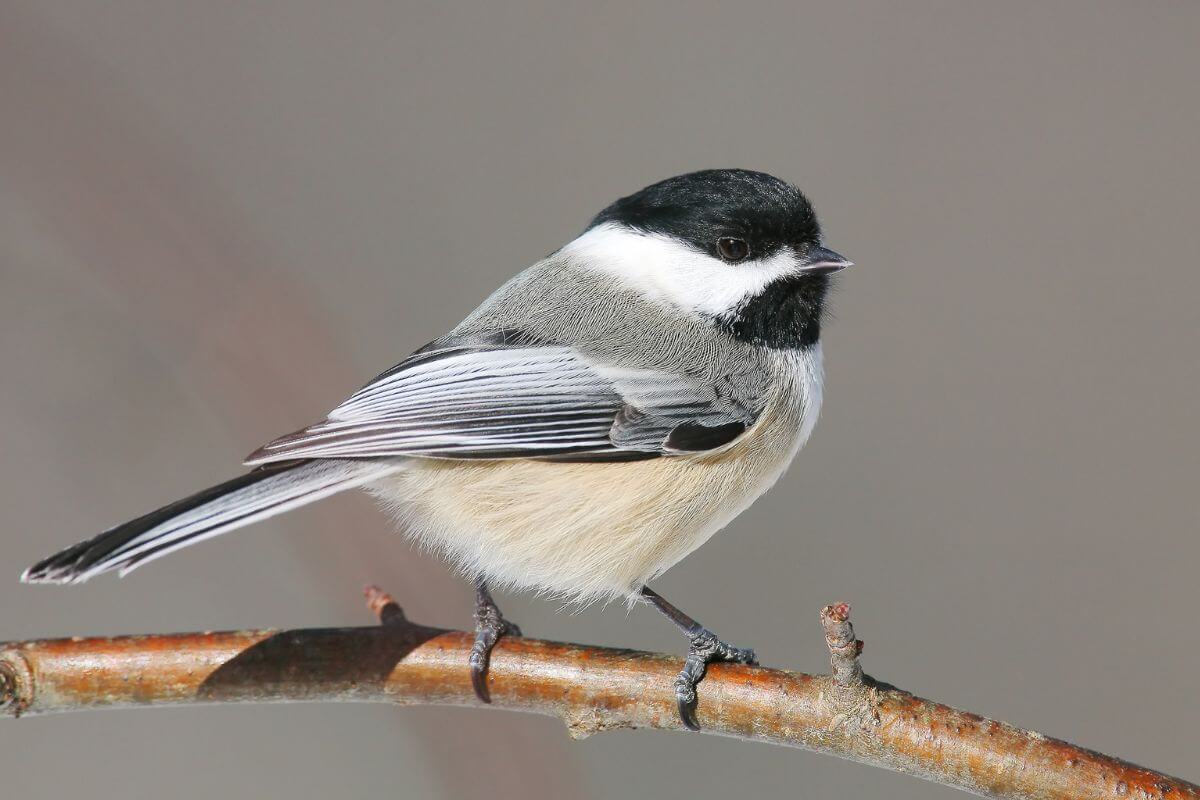
| Key Characteristic | Details |
|---|---|
| Scientific Name | Poecile atricapillus |
| Family | Paridae (Chickadees) |
| Habitat | Forests |
| Food | Insects, seeds, and berries |
| Color | Solid black cap and bib, white cheeks |
I love pointing out the Black-capped chickadee to my pals when we’re birdwatching. It’s like the poster child for cuteness. With its big head and small body and its ability to check out everything around it, including us, it’s a favorite for many.
One cool thing about these little guys is that you can often hear them before seeing them. They’re curious enough to check out what’s making those bird-like sounds — even mimicking other birds or curious birders’ pishing sounds. It makes spotting them a lot more fun!
Here are some neat facts about the Black-capped chickadee:
- Black-capped chickadees are smart about food, hiding dozens of seeds and other bits of food for when they’re hungry later.
- Black-capped chickadee calls are like a secret language, sharing all kinds of info about who’s who and what’s where in the bird world.
- If you listen closely, you can tell the threat level by how many “dee” notes the Black-capped chickadee adds to their call.
- Black-capped chickadees search for food sources such as insects, spiders, seeds, and fruit in wooded habitats. It’s also known to visit feeding stations.
The way Chickadees work together and stay on top of their surroundings always makes me respect these little grayish birds more. They might be small but can survive and thrive in the wild.
8. Brown-Headed Cowbird
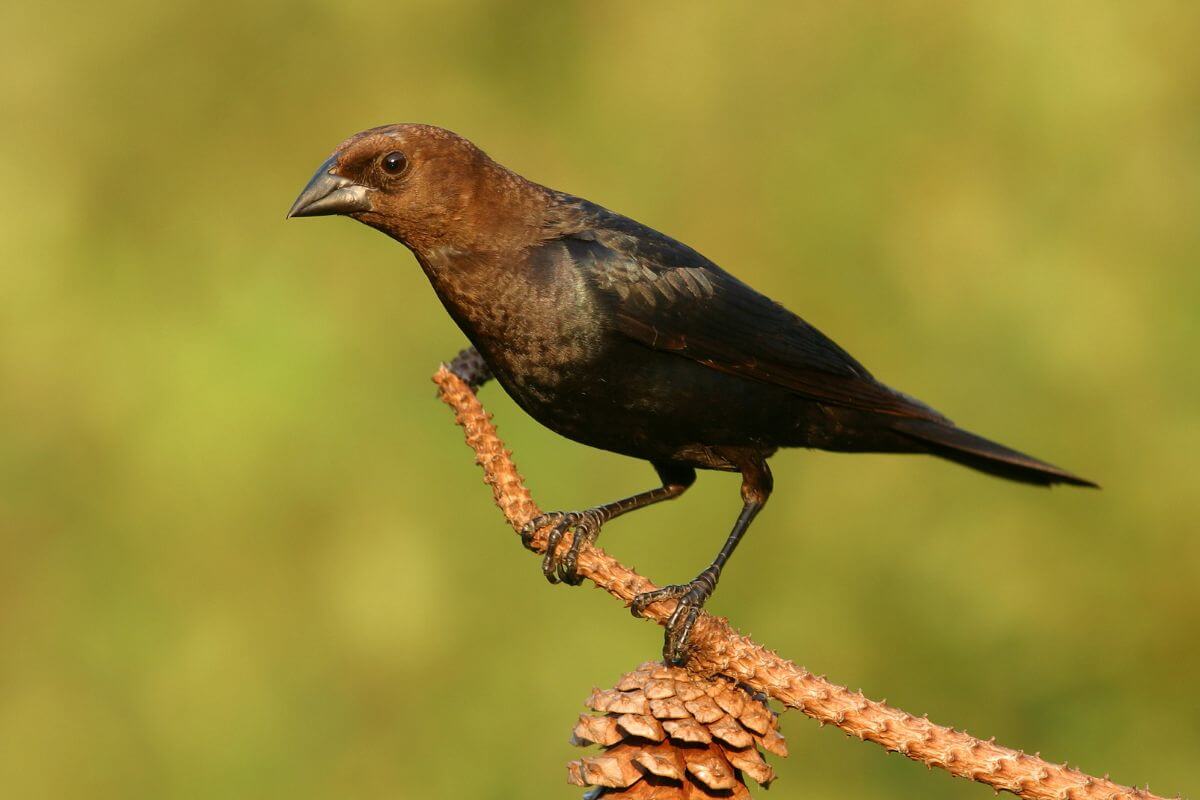
| Key Characteristic | Details |
|---|---|
| Scientific Name | Molothrus ater |
| Family | Icteridae (Blackbirds) |
| Habitat | Grasslands |
| Food | Anthropods and seeds |
| Color | Glossy black plumage and a rich brown head |
Noticing Brown-headed cowbirds in Montana adds a twist to birdwatching routines. Their stout heads and compact tails easily distinguish these smallish blackbirds. When you glance at their beaks, you’ll notice they have a thick, short structure that sets them apart from other birds. Their beaks are similar to that of a finch.
Some interesting facts about Brown-headed cowbirds:
- Adding fascination to their sight is that Brown-headed cowbirds are nature’s “brood parasites,” quite the freeloaders.
- It’s amazing (and a bit cheeky) how Brown-headed cowbirds put their eggs in the nests of over 220 other bird species.
- Brown-headed cowbirds are also quite vocal, making various sounds ranging from clicks and whistles to gurgling tunes.
These birds are mostly found roaming grasslands and might visit the state’s fields and meadows. Listen carefully, and you might recognize their different calls. The males are known for their soothing gurgling tunes, while the females engage in more chattering conversations.
9. Canada Goose
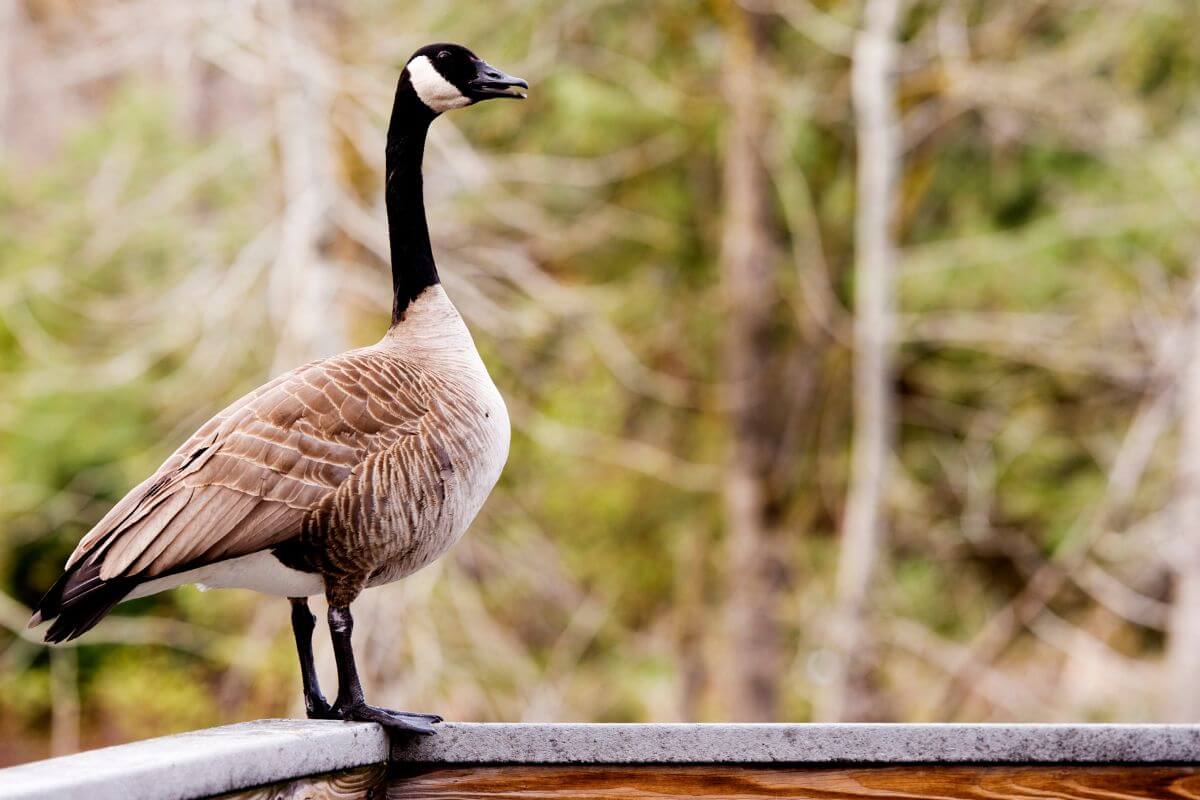
| Key Characteristic | Details |
|---|---|
| Scientific Name | Branta canadensis |
| Family | Anatidae (Swans/Geese/Ducks) |
| Habitat | Marshes |
| Food | Wheat and corn fields |
| Color | Black head with white cheeks |
The Canada Goose is a common big bird seen in fields and parks. Its distinguishing features are its black neck and white chinstrap mark. Thousands of these birds fly in V-shaped formations in the sky and make honking sounds as they migrate north and south, making them quite a spectacle to observe.
Here are some interesting tidbits about Canada Goose:
- You’ll find Canada Geese in and around water bodies during the warmer months, relaxing on the shores or munching on grass.
- Canada Geese follow a “assortative mating” pattern when choosing a partner. They often pick a mate similar in size.
- Biologists have identified about 11 subspecies of the Canada Goose, although only a few have unique characteristics.
- Canada Geese feed by skimming the water or nibbling on grass in vast open areas.
Seeing these geese is a sign of the changing seasons, with their flights in large groups a sight. Their preference for the great outdoors doesn’t just make them breathtaking. It also makes them easier for us to spot and appreciate.
10. Common Goldeneye
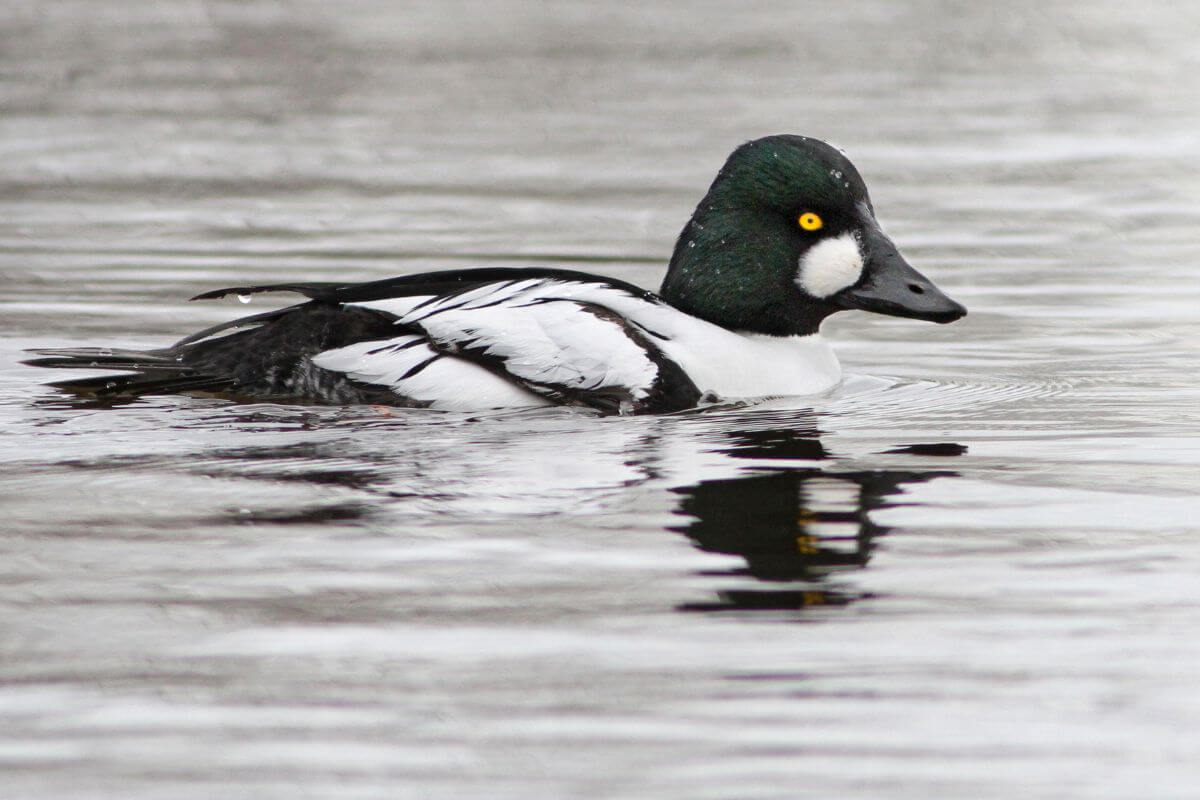
| Key Characteristic | Details |
|---|---|
| Scientific Name | Bucephala clangula |
| Family | Anatidae (Swans/Geese/Ducks) |
| Habitat | Forested wetland habitats |
| Food | Aquatic invertebrates |
| Color | Mostly black and white |
Common Goldeneyes are medium-sized ducks with large heads and short tails. They are diving ducks, meaning they swim underwater to find food.
You can typically find Common Goldeneyes in flocks on larger bodies of water. Their unique head shape and bright yellow eyes make them stand out, easily catching the eye from a distance.
Some fascinating facts about the Common Goldeneye:
- Hunters called the Common Goldeneye “whistler” because its wings have a whistling sound when they fly.
- Female Common Goldeneyes often lay their eggs in the nests of other females, especially in nest boxes.
- Common Goldeneyes build their nests in tree cavities and man-made nest boxes. The female carefully prepares the nest by creating a shallow, down-feather-lined hollow at the bottom.
Seeing these ducks in action is quite a sight, especially when they take to the water or sky. Keep an eye out for that bright yellow eye, it might lead you to a flock of Common Goldeneyes enjoying their wetland paradise.
11. Common Grackle
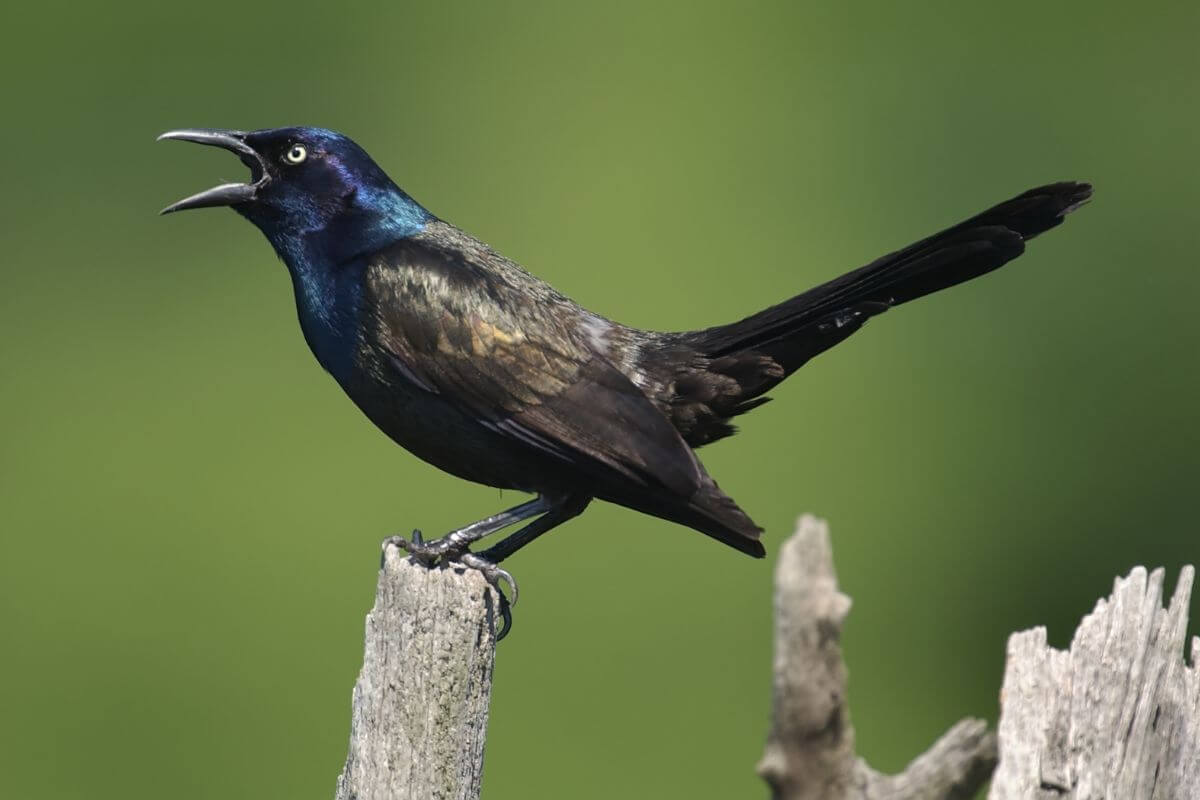
| Key Characteristic | Details |
|---|---|
| Scientific Name | Quiscalus quiscula |
| Family | Icteridae (Blackbirds) |
| Habitat | Open woodland and forest edges |
| Food | Insects, seeds and invertebrates |
| Color | Purple heads on bronze-iridescent bodies, black from afar |
The Common Grackle stands out with its purple-tinged head and bronze-iridescent body, looking like it’s been slightly stretched. Scan for the tallest, longest-tailed blackbirds and starlings to locate them in a group. Their elongated bodies, tapered bills, and glossy sheens distinguish them from other blackbirds.
Here are a few intriguing facts that give insight into the habits of Common Grackles:
- Common Grackles’ long tails occasionally fold into a shallow V shape in flight, adding to their distinctive appearance.
- Common Grackles have a penchant for corn, establishing their position as the #1 threat to corn fields by consuming both ripened and corn sprouts.
- Called ‘anting,’ Common Grackles sometimes stand hunched on the ground, allowing ants to crawl over them. This helps remove parasites as the ants secrete formic acid, the same chemical found in their stings.
The Common Grackle is fascinating, but understanding its habits and role in nature adds an extra layer to the birdwatching experience. So next time you observe blackbirds, watch for their large and glossy relatives.
12. Common Merganser
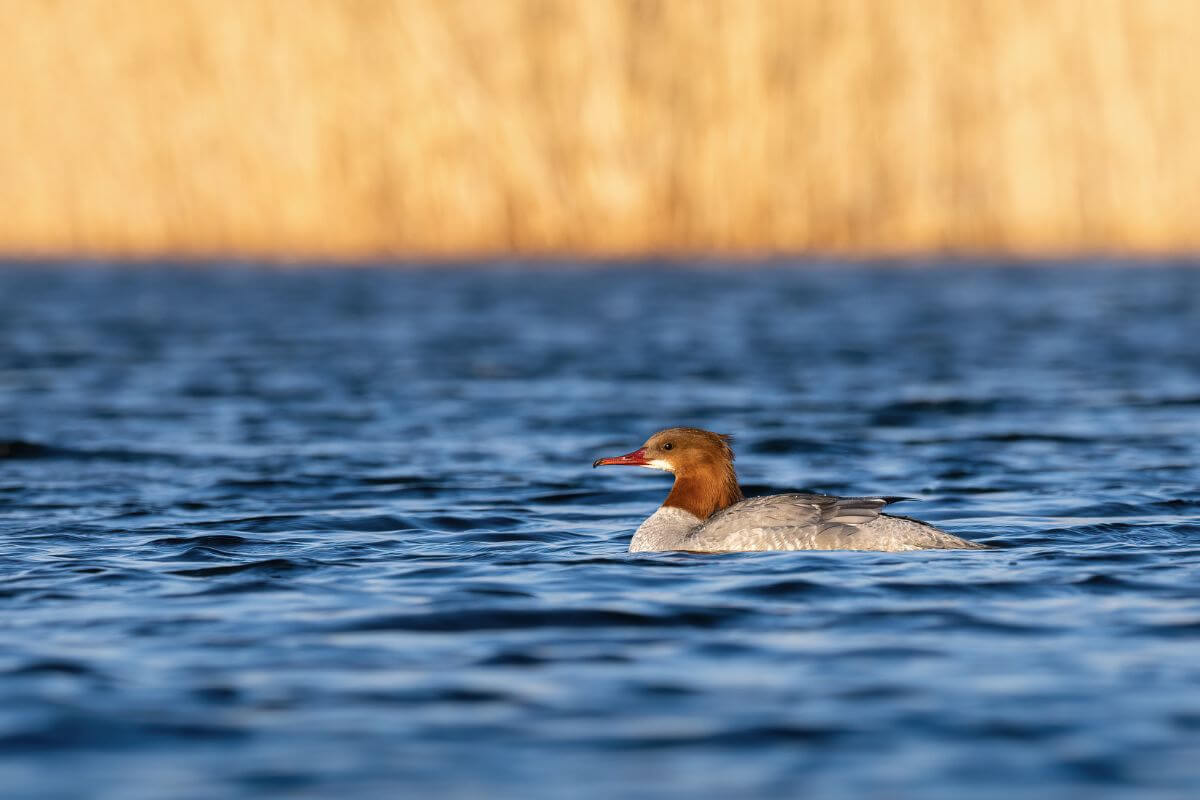
| Key Characteristic | Details |
|---|---|
| Scientific Name | Mergus merganser |
| Family | Anatidae (Swans/Geese/Ducks) |
| Habitat | Large lakes and large rivers |
| Food | Small fish |
| Color | White bodies and dark, iridescent-green heads |
Common Mergansers are like the supermodels of the duck world. With their long, sleek bodies and slender wings, they look amazing as they glide along rivers or sit atop rocks. You can’t miss them when they fly, as those white wing patches stand out.
Here are some facts about the Common Merganser worthy to know:
- Common Mergansers hunt for their fish meals by diving underwater. Seeing them gracefully swim and plunge below the surface is a sight.
- Common Mergansers typically make their nests in natural tree cavities or holes carved out by large woodpeckers.
- Common Mergansers’ snowy white bodies and striking dark, iridescent-green heads are easily recognizable in Montana’s waters.
The Common Merganser is the perfect example of how striking and varied Montana’s bird population is. Look along the riverbanks, you might just catch these breathtaking ducks in action.
13. Common Raven
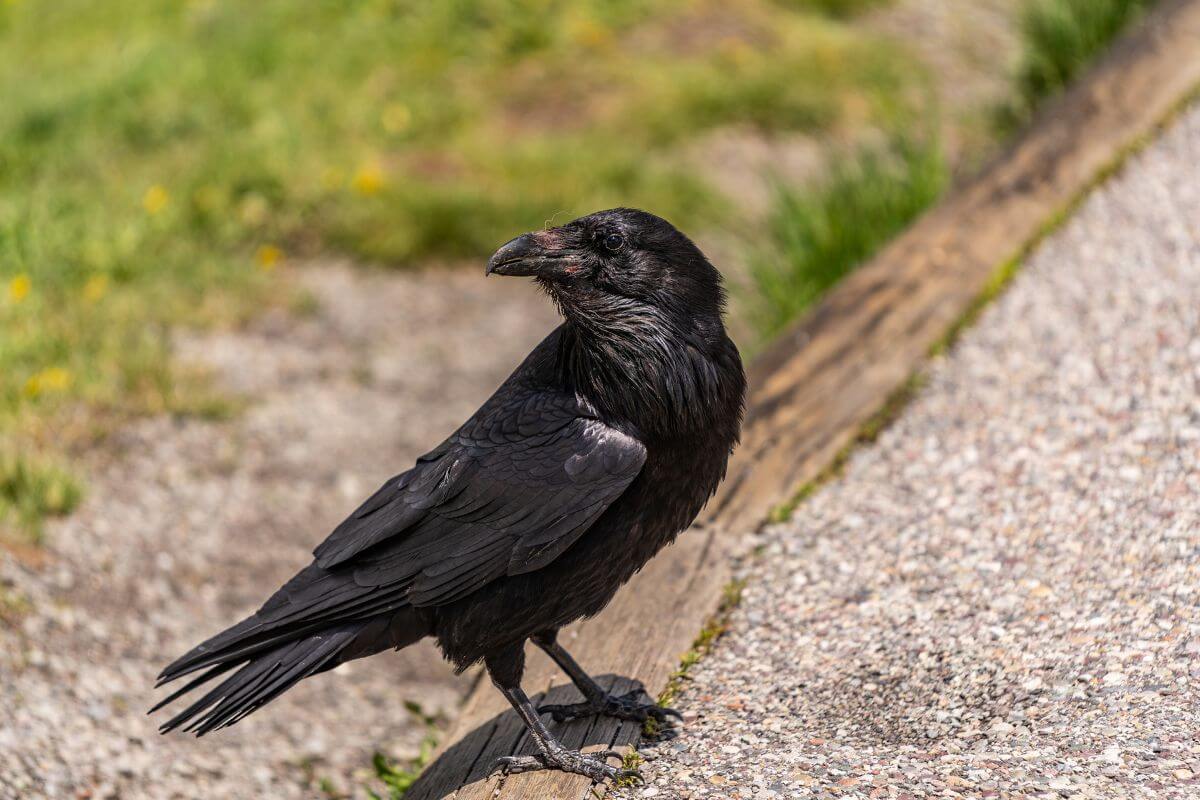
| Key Characteristic | Details |
|---|---|
| Scientific Name | Corvus corax |
| Family | Corvidae (Jays/Crows/Magpies) |
| Habitat | Forests |
| Food | Small mammals, nesting birds, eggs, and berries |
| Color | Entirely black |
The Common Raven stands out with its entirely black coloring and broad wings. They are the most intelligent among birds, mastering even challenging puzzles designed by creative scientists.
Throughout history, the fascinating Common Raven has been a faithful companion to people across the Northern Hemisphere. They trail after wagons, sleds, and hunting parties, hoping to catch a quick meal.
Here are some interesting bits about the Common Raven’s behaviors and characteristics:
- Common Ravens are known for acrobatic flights, often rolling and somersaulting in the air.
- Common Ravens’ intelligence poses a unique danger. They’ve been observed lurking in trees and waiting for ewes to give birth, only to attack the newborn lambs.
- Common Ravens are skilled mimics, capable of imitating other bird species’ calls and even human words when raised in captivity.
- Common Ravens are one of the world’s most widespread naturally occurring bird species.
Look for these birds on the fringes of towns, especially near landfills, in foothill forests, scrub areas, and deeper into the forests of mountains and national parks. You’ll know they’re near when you hear a deep, resonant croak from above.
14. Dark-Eyed Junco
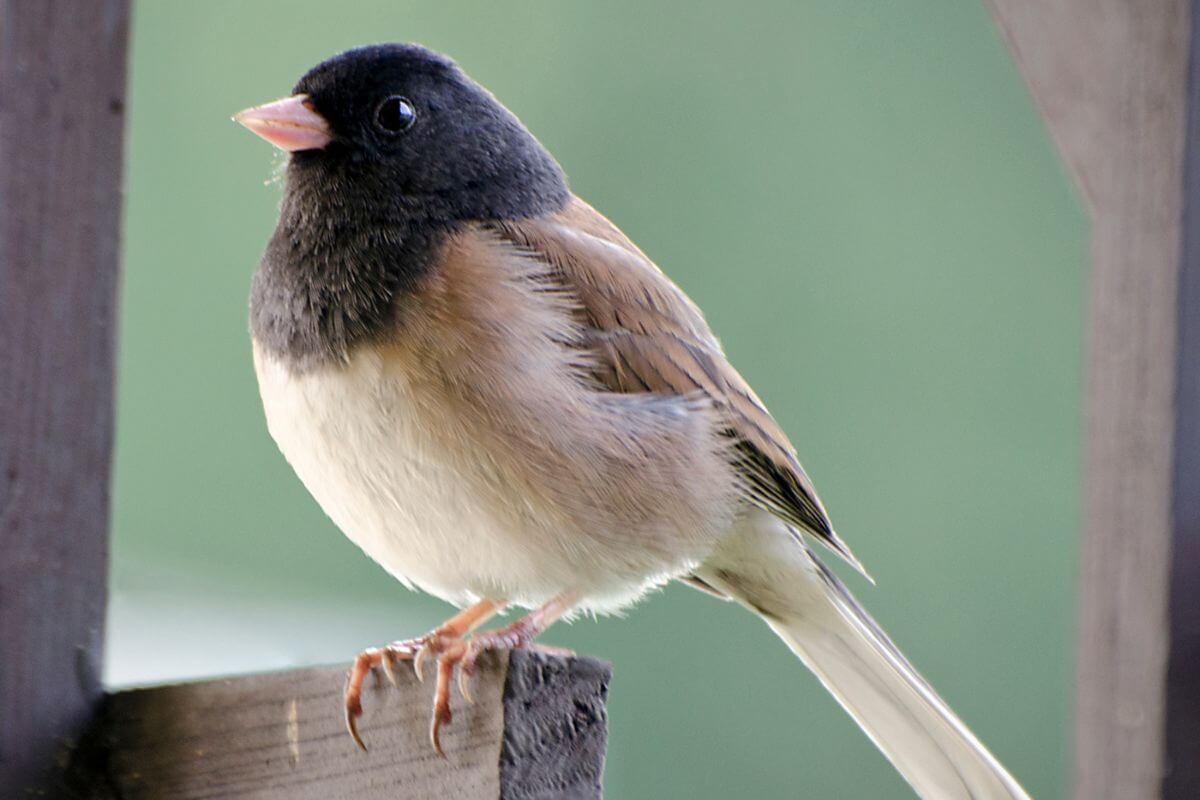
| Key Characteristic | Details |
|---|---|
| Scientific Name | Junco hyemalis |
| Family | Passerellidae (New World Sparrows) |
| Habitat | Forests |
| Food | Seeds and arthropods |
| Color | Dark gray or brown birds |
Dark-eyed juncos are among the most common birds in North America. They can be easily spotted with their dark gray or brown coloring, especially the bright white tail feathers that flash when they’re in flight.
Here are a few more things about Dark-eyed juncos that you might find fascinating:
- Dark-eyed juncos love living in forests and are known for their clear but uniquely different markings.
- Known as a bird of the ground, Dark-eyed juncos hop around the bases of trees and shrubs or venture onto lawns in search of fallen seeds.
- Dark-eyed junco nests are unique. Instead of perching high up, they prefer cup nests snugly placed on the ground, under fallen logs, deep roots, and other hidden spots.
- Dark-eyed juncos are known for producing a distinct, piercing sound that goes “pik!”. On breeding grounds, male members of the species emit a brief, unadorned warble that sounds like “sipsipsipsipsipsipsip”.
When looking for them, just stroll through open areas with scattered trees and shrubs. The Juncos love to stay close to the ground, searching for good food like seeds and arthropods. Listen closely for their gentle twittering calls or the sweet trill of their song, it can help you track them down more easily.
15. Downy Woodpecker
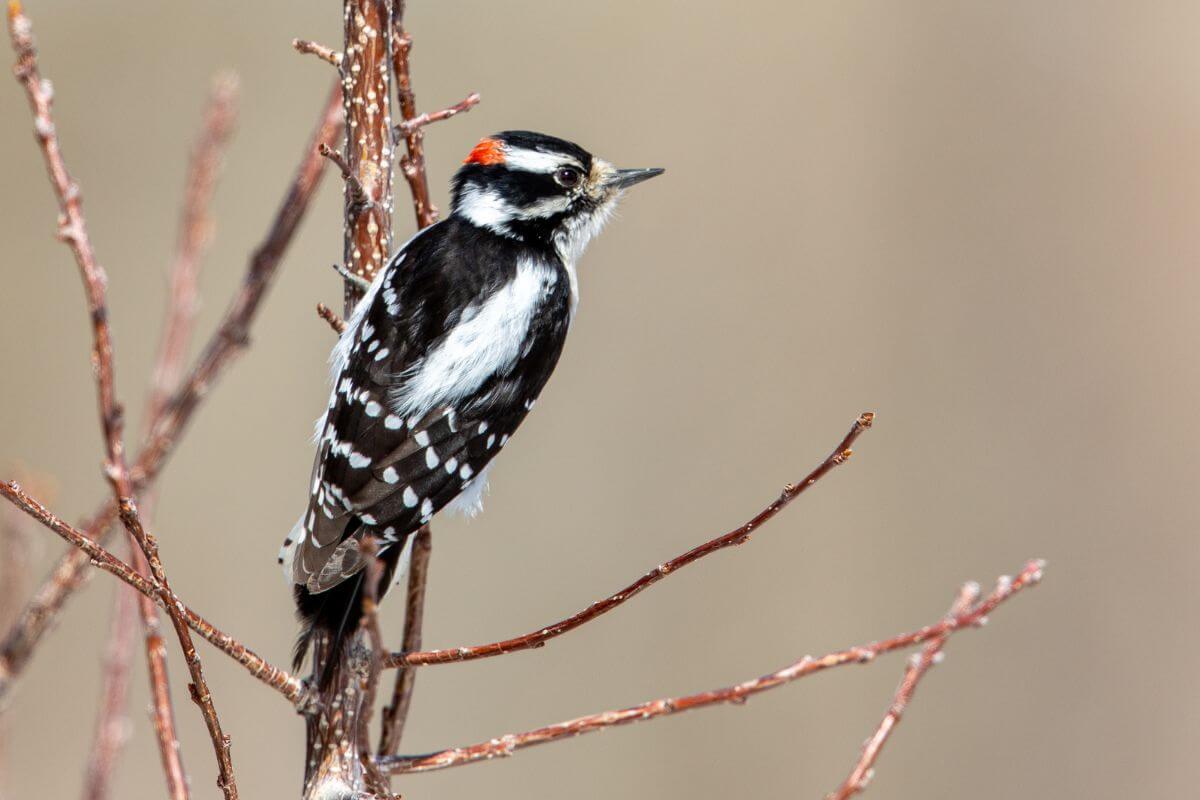
| Key Characteristic | Details |
|---|---|
| Scientific Name | Dryobates pubescens |
| Family | Picidae (Woodpeckers) |
| Habitat | Lakes and ponds |
| Food | Open riparian and deciduous woodlands |
| Color | Checkered black-and-white birds |
Downy Woodpeckers are found in habitats near lakes and ponds, loving open riparian and deciduous woodlands. What’s unique about them is how acrobatic they are while foraging. They’re often seen on small branches or balancing on slender plant galls, sycamore seed balls, or suet feeders.
Here are a few fascinating tidbits about the Downy Woodpecker:
- Downy Woodpecker males have a brilliant red spot on the nape, setting them apart from the females.
- While Downy Woodpeckers don’t sing, they create quite a ruckus by drumming loudly on wood or metal to achieve the same effect.
- Spring and summer are noisier times, with little Downy Woodpeckers creating a buzz with their shrill calls and drumming activities.
You don’t have to venture too far to spot Downy Woodpeckers. They frequent woodlots, neighborhoods, and even city parks. If you pay close attention, you might hear their distinct high-pitched pik note and a whiny call that trails off melodically.
16. Eurasian Collared-Dove
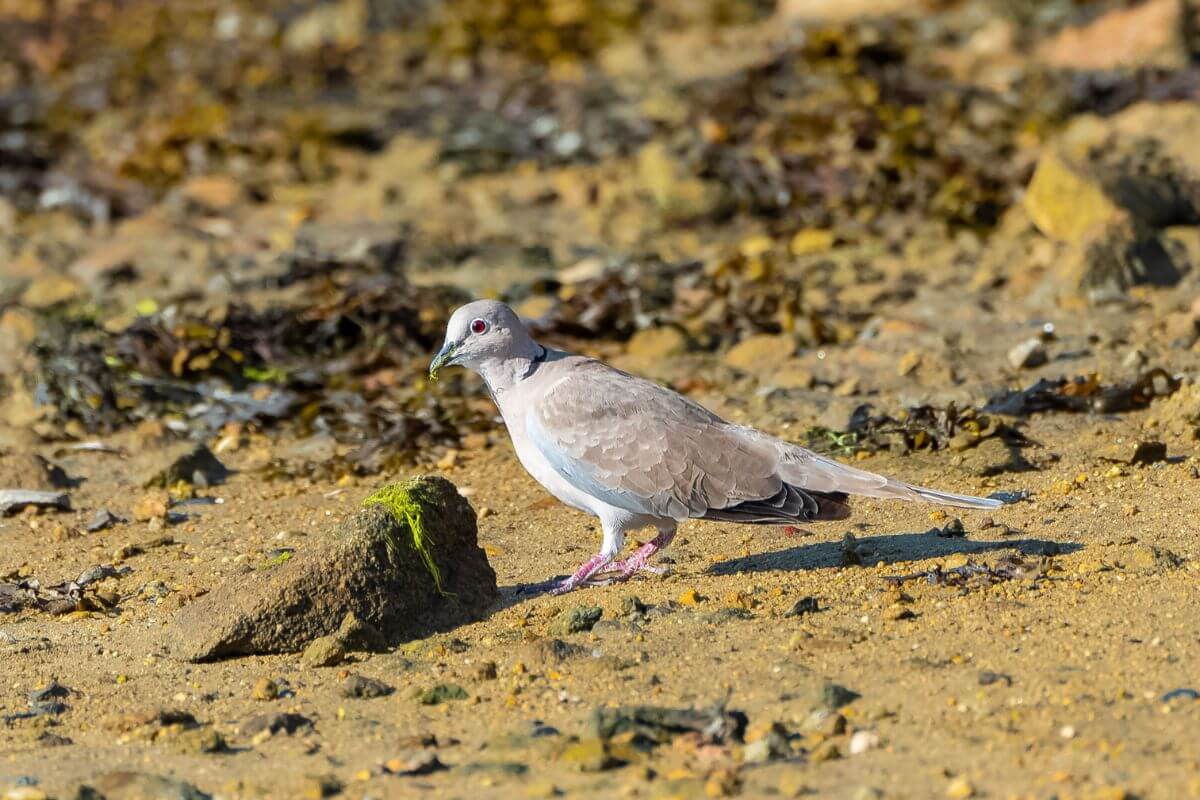
| Key Characteristic | Details |
|---|---|
| Scientific Name | Streptopelia decaocto |
| Family | Columbidae (Pigeon/Doves) |
| Habitat | Towns |
| Food | Seeds |
| Color | Chalky light brown to gray-buff birds with small black spots on their wings |
The Eurasian Collared-Dove was introduced from Europe and quickly colonized North America. The species was first observed in Montana in 1997 but has now taken over the state, particularly in towns.
At first glance, the Eurasian Collared-Dove might be mistaken for the native Mourning Dove. However, they stand out with their larger size, heavier build, and distinctive black collar on the back of their necks. Their broad square tail and dark-tipped wings also help distinguish them when in motion.
These doves are often found perched on phone wires or fence posts, and their arrival is often accompanied by a noticeable noise. Their rhythmic cooing sets a unique tone, with a slightly different cadence from the Mourning Dove.
Here are some interesting facts about Eurasian Collared-Doves:
- Eurasian Collared-Doves are among the few bird species that can drink by submerging their bills and sucking water, just like sipping through a straw.
- Eurasian Collared-Doves showcase quirky habits when walking, bobbing their heads and flicking their tails.
- Eurasian Collared-Doves’ messy stick nests are typically found in trees or structures close to human activity.
Observing the Eurasian Collared-Dove is not just about spotting a unique bird, it’s an opportunity to witness its blend of natural and human-like behaviors.
17. European Starling
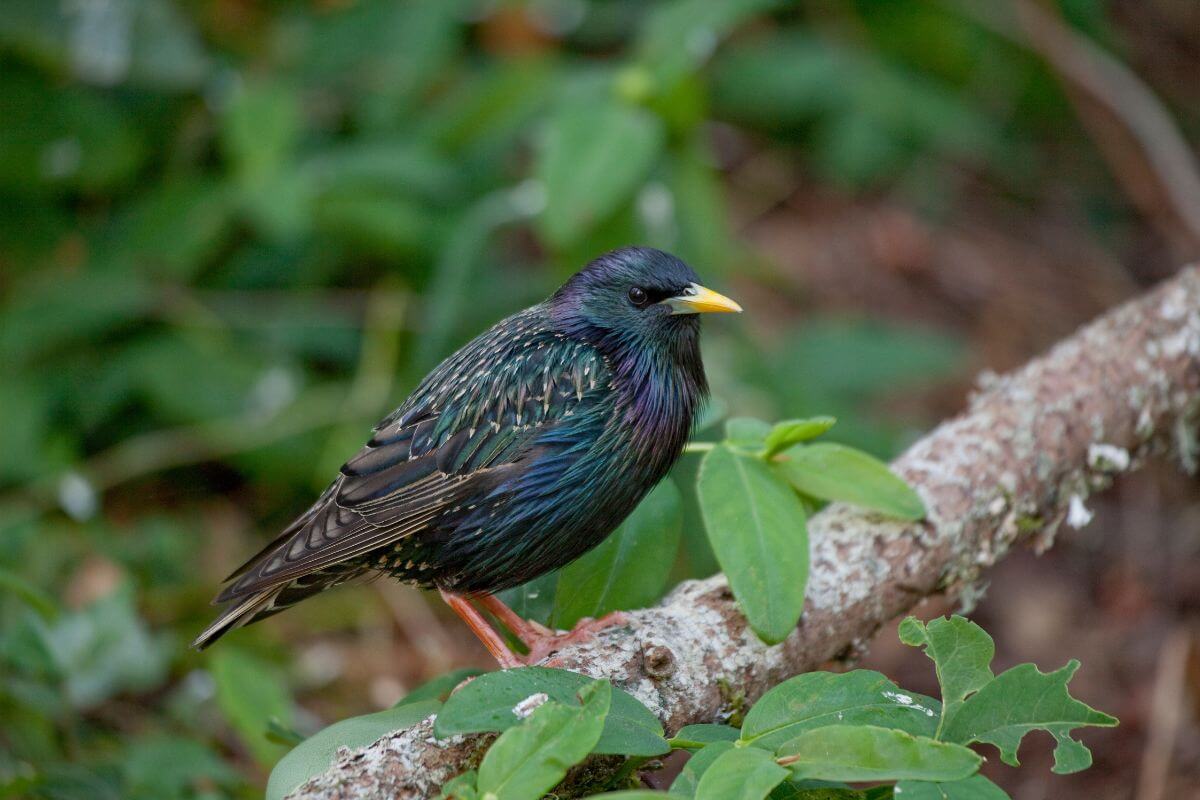
| Key Characteristic | Details |
|---|---|
| Scientific Name | Sturnus vulgaris |
| Family | Sturnidae (Starlings) |
| Habitat | Towns |
| Food | Insects |
| Color | Purplish-green iridescent with yellow beaks |
European Starlings are among Montana’s most common birds in urban and rural areas. They were brought over to North America by Shakespeare enthusiasts in the 19th century. Today, European Starlings are everywhere, from lawns to city parks.
Their appearance is unique, with shiny purple-green feathers and bright yellow beaks. While some might find their aggressive nature and large numbers challenging, they’re remarkable creatures when you take the time to observe them.
Here are some exciting facts about European Starlings:
- European Starlings are fantastic at imitating other bird calls, mastering up to 20 species.
- European Starlings’ colors change seasonally from light to dark, which happens without molting their feathers.
- European Starlings are fast fliers, reaching speeds of around 48 mph (77 kph).
- European Starlings are noisy, especially in big groups with blackbirds and grackles.
When looking for European Starlings, listen for their active, communicative calls and look for their soft cup nests. They build nests in tree cavities, nest boxes, or other suitable spots.
18. Gadwall
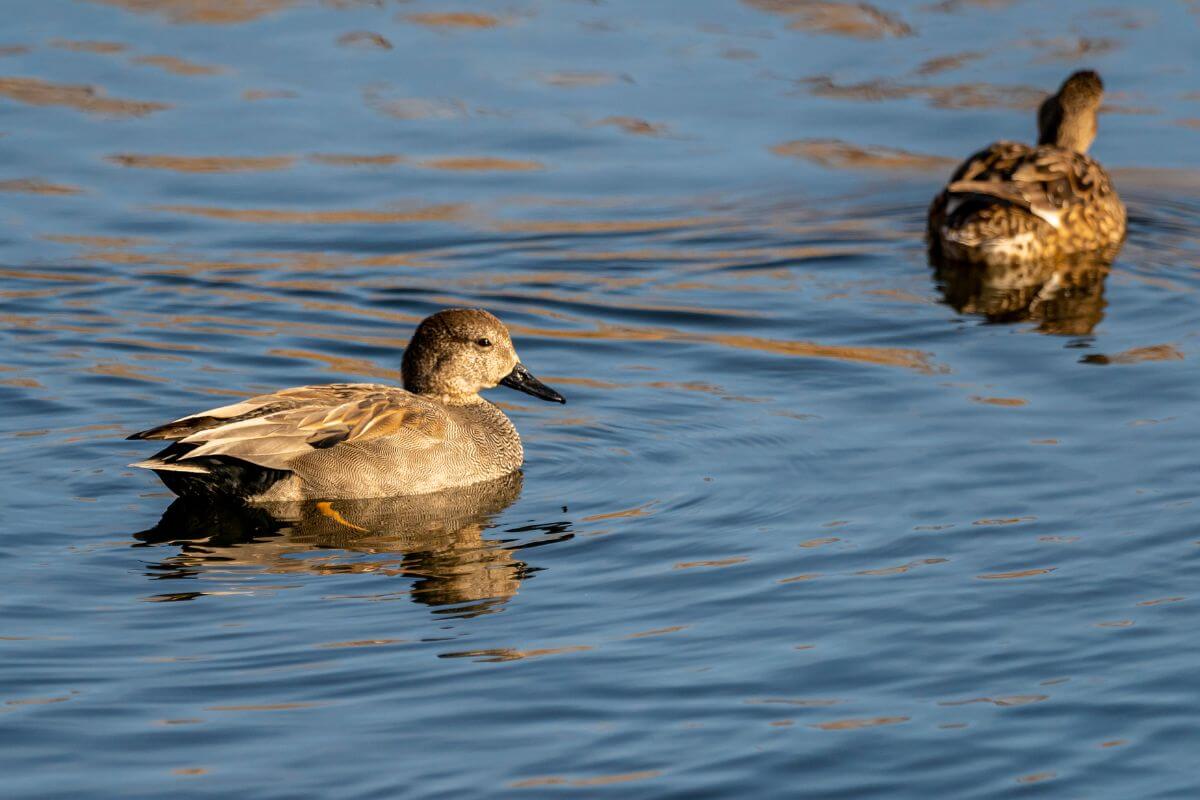
| Key Characteristic | Details |
|---|---|
| Scientific Name | Mareca strepera |
| Family | Anatidae (Swans/Geese/Ducks) |
| Habitat | Saline lowlands |
| Food | Submerged aquatic vegetation, seeds, and aquatic invertebrates |
| Color | Gray-brown with a black patch at the tail |
The Gadwall is an average-sized duck easily spotted by its white belly and small white patches on each wing. Typically, the male Gadwall sports a gray body with some touches of tan on its wings, a pale gray-brown head, and a striking black beak.
Here are some cool facts to know about Gadwalls:
- Gadwalls are known for acting as food “pirates,” snatching snacks from diving ducks when they come up for air. They would also steal food from American Coots and other ducks.
- If you’re around during Gadwalls’ vocal moments, you might hear their distinctive, nasal quacking calls, which sound something like “reh reh reh reh reh.”
- Gadwalls nest on the ground in meadows and areas with tall grass, creating shallow scrapes hidden within the dense vegetation.
When looking for Gadwall, head to small bodies of water rich with aquatic plants. They have a unique feeding style, often swimming in slightly deeper water than other dabbling ducks.
19. House Finch
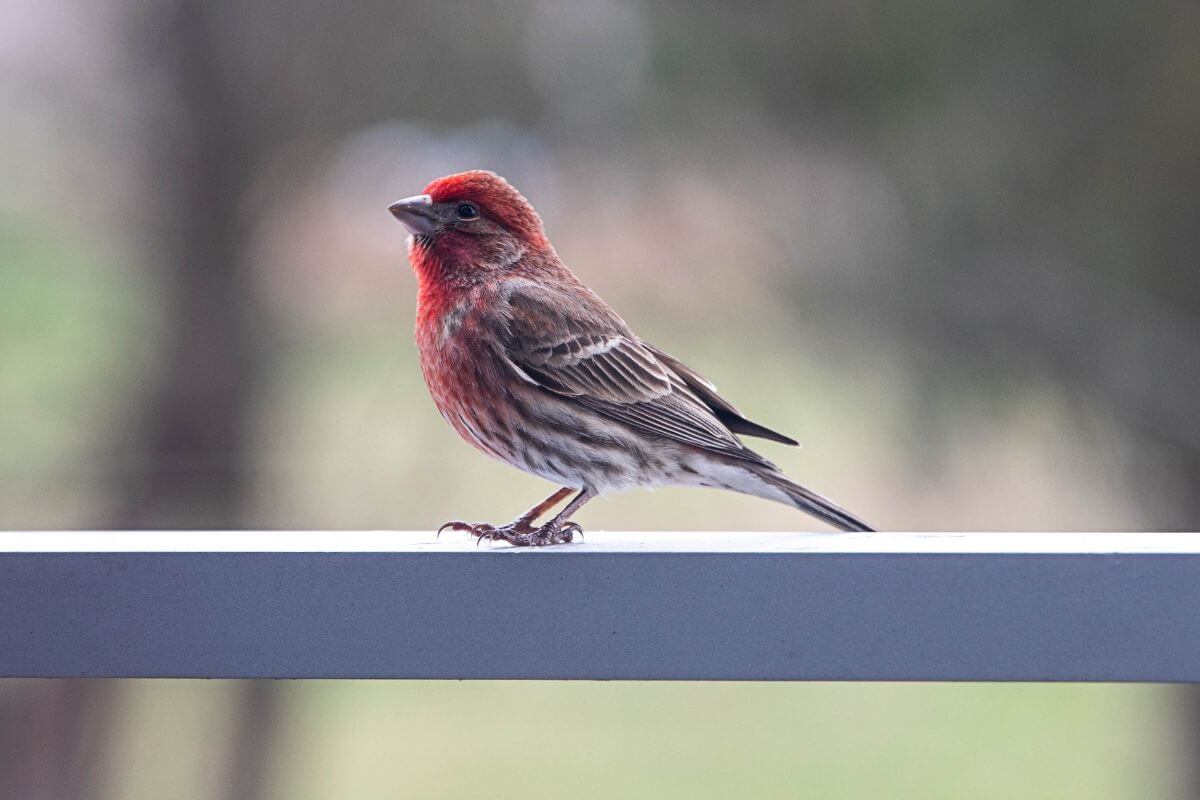
| Key Characteristic | Details |
|---|---|
| Scientific Name | Haemorhous mexicanus |
| Family | Fringillidae (Finches) |
| Habitat | Towns |
| Food | Vegetable matter including buds, seeds, and fruits |
| Color | Rosy red to plain grayish-brown |
House Finches have a distinct appearance, characterized by their small bodies and relatively large beaks. Interestingly, their short wings give the illusion of a long tail.
Here are a few cool bits about the House Finch:
- House Finches’ vibrant colors range from rosy red to plain grayish-brown, adding a vivid touch to the urban landscape.
- Male House Finches owe their fiery red hues to the pigments in their food, which become more intense during the molt.
- House Finches choose plant-based food exclusively for their young, a rare practice in the bird world.
The House Finches are quite the social butterflies. They favor the ambiance of towns and are usually found in bustling groups, making them a lively addition to any bird-spotting outing.
20. House Sparrow
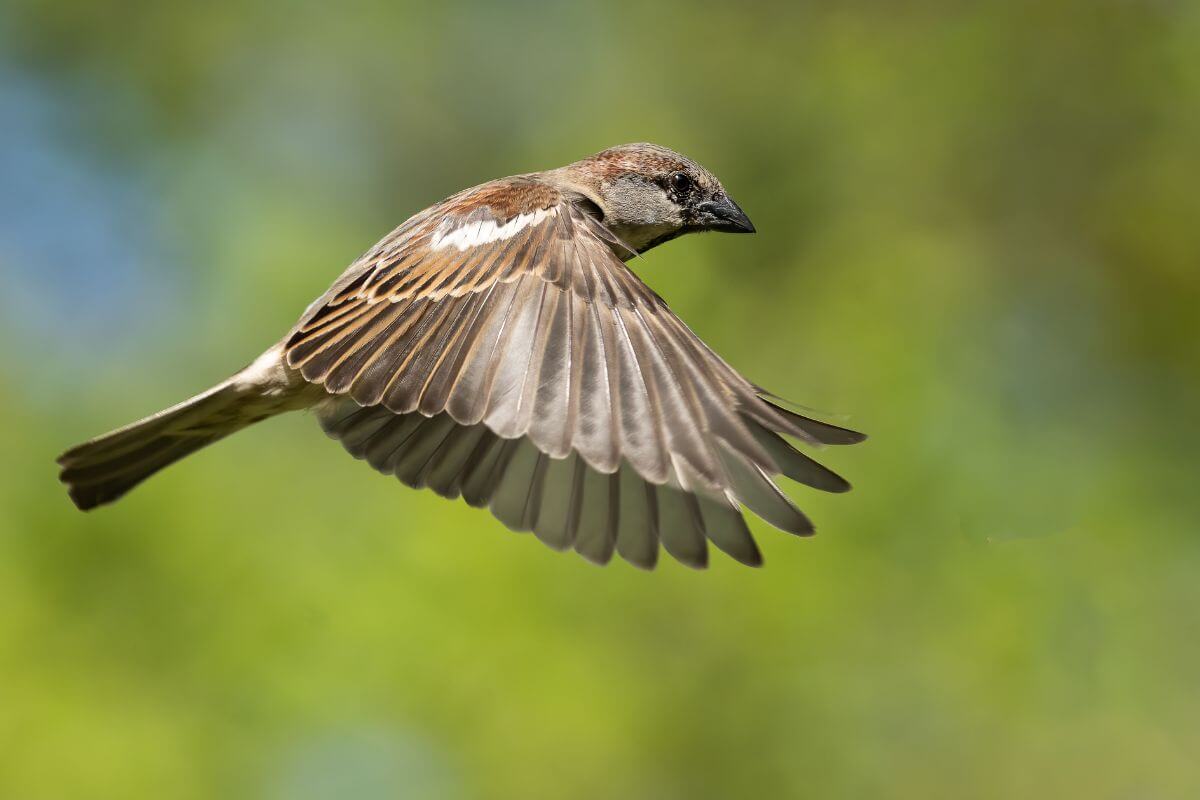
| Key Characteristics | Details |
|---|---|
| Scientific Name | Passer domesticus |
| Family | Passeridae |
| Habitat | Farms, and residential and urban areas |
| Food | Livestock feed |
| Color | Brightly colored to plain buffy-brown overall |
The House Sparrow is quite distinctive, not just because of its behavior but also because of its look. These sweet birds are a blend of beautifully bright colors and buffy browns.
House Sparrows are often the chunkier sparrows of their kind, with prominent chests and robust features. Spotting them is usually easier in urban places or around farms near humans, as they’ve lived beside us for ages.
You might want to bring some treats to catch sight of a House Sparrow in action. They are known to love chomping on livestock feed. If you’re lucky, they might even fly to your hand for a snack.
Here are some quick facts that show just how fascinating House Sparrows are:
- The Dust Bath Dance – House Sparrows like to stay clean and fresh. But unlike most birds, they prefer dust and soil. Seeing them throw dust over themselves as if they’re having a little party is quite a sight.
- Urban Nesters – Rather than building their nests in trees like some other birds, House Sparrows are big fans of our buildings. You might find their nests tucked under your eaves or even in a cozy nest box you put out for them.
- Daring Dinners – When food is hard to find, House Sparrows get creative. They’ve been spotted snatching snacks from American Robins and even stealing nectar by poking holes in flowers.
- Housing Habits – House sparrows are quite protective of their homes. If they’re looking for a place to set up their nest and find it’s already taken, they won’t hesitate to make room by removing the eggs or young from other birds’ nests, like Eastern Bluebirds.
One thing is sure: House Sparrows bring a bit of liveliness and charm wherever they go. They’re a pleasure to watch, especially when you know more about their habits.
21. Killdeer
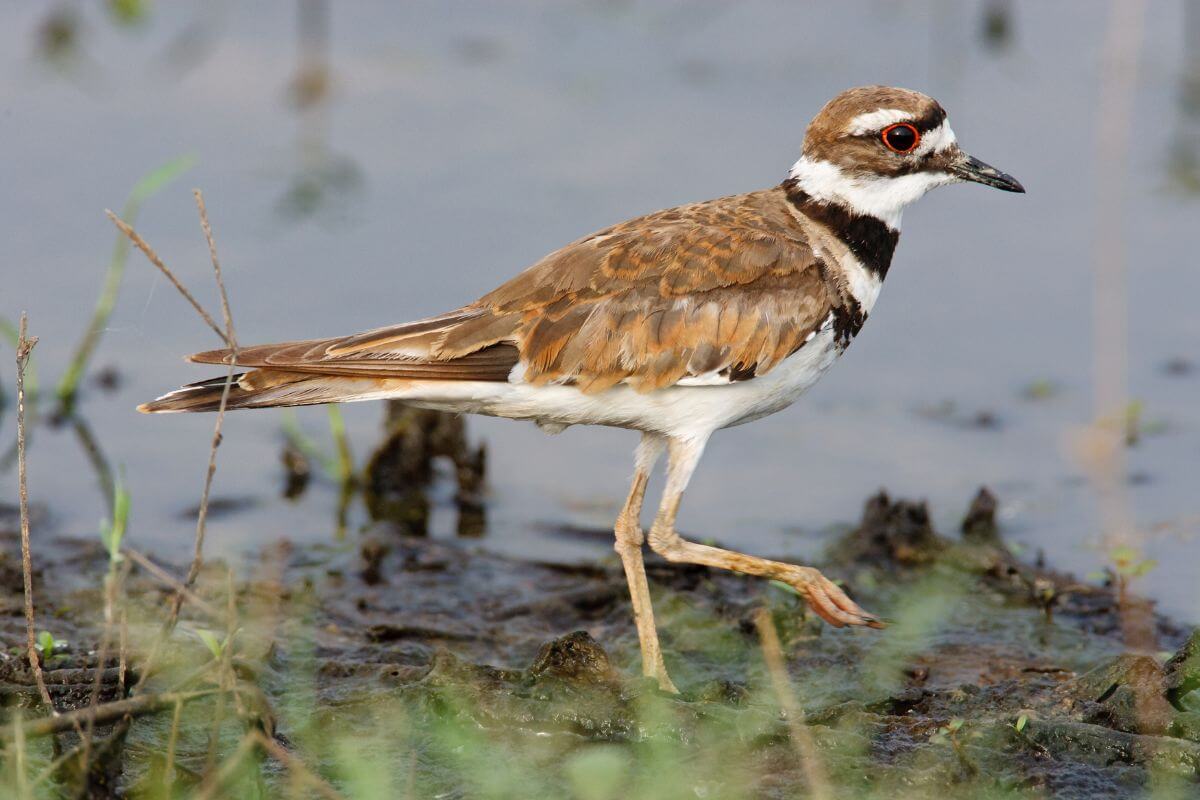
| Key Characteristics | Details |
|---|---|
| Scientific Name | Charadrius vociferus |
| Family | Charadriidae (Plovers) |
| Habitat | Grasslands |
| Food | Terrestrial invertebrates, especially earthworms |
| Color | Brownish tan on top and white below |
Killdeer are unique in their habitat preference for grasslands and are central to many terrestrial ecosystems. These slender and lanky birds boast a large, round head, particularly large eyes, and short bill.
The killdeer bird is known for its loud and far-reaching call that sounds like “kill-deer”. Interestingly, this call can often be heard at night, particularly when the birds fly overhead in circles.
Let’s dive into some intriguing facts about the Killdeer that set them apart:
- The Killdeer’s name is derived from the resonant, wailing “kill-deer” call they frequently make.
- The Killdeer is a well-known bird that typically lives in dry habitats. Despite this, it is actually able to swim quite well, although it is one of the shorebirds that is least associated with water.
The Killdeer is a beautiful and common sight. It is often seen in places not usually frequented by shorebirds, such as lawns, golf courses, and parking lots. They are a living testament to nature’s adaptability.
22. Mallard
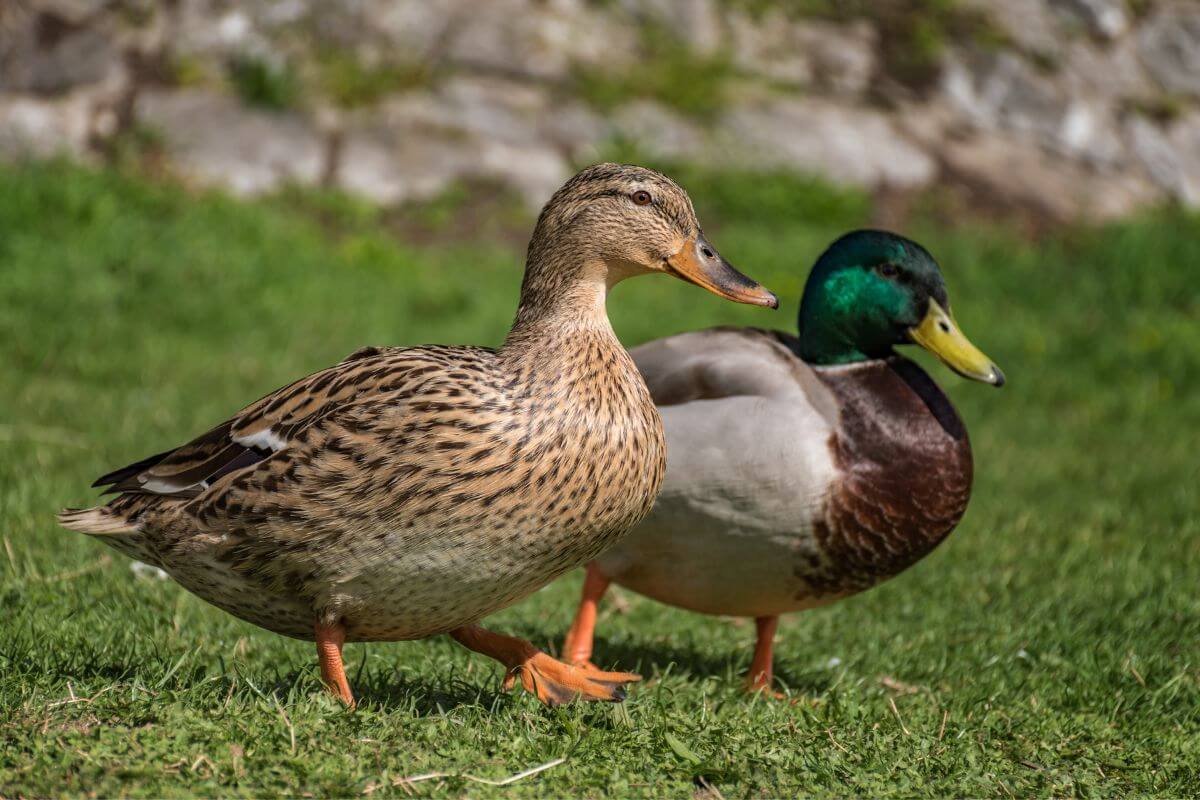
| Key Characteristics | Details |
|---|---|
| Scientific Name | Anas platyrhynchos |
| Family | Anatidae (Swans/Geese/Ducks) |
| Habitat | Uplands close to water |
| Food | Plants, insects, and shellfish |
| Color | Brown to mottled brown |
The Mallard is the most common duck species in North America. It is known to be adaptable and resilient in the wild, even in cold climates and areas where humans are present.
Adding to the intrigue of the Mallard, here are some fascinating facts:
- Hunting Mallards for consumption has been a common practice in Montana and elsewhere for a long time.
- Most domestic duck breeds have Mallard lineage, although they are distinguishable by their more robust build than their wild counterparts.
- Regarding vocalization, the standard duck quack is the sound of a female Mallard. Males have their distinct way of communicating — a softer, rasping call.
- Classified as “dabbling ducks,” Mallards have a unique feeding habit. They forage for food in water by submerging their heads and grazing on aquatic plants.
If you’re eager to observe Mallards up close, local parks in urban and suburban areas are excellent places, especially if park-goers feed them. For a more natural encounter, look no further than ponds or lakes, where Mallards are likely to be the predominant duck species.
23. Mountain Bluebird
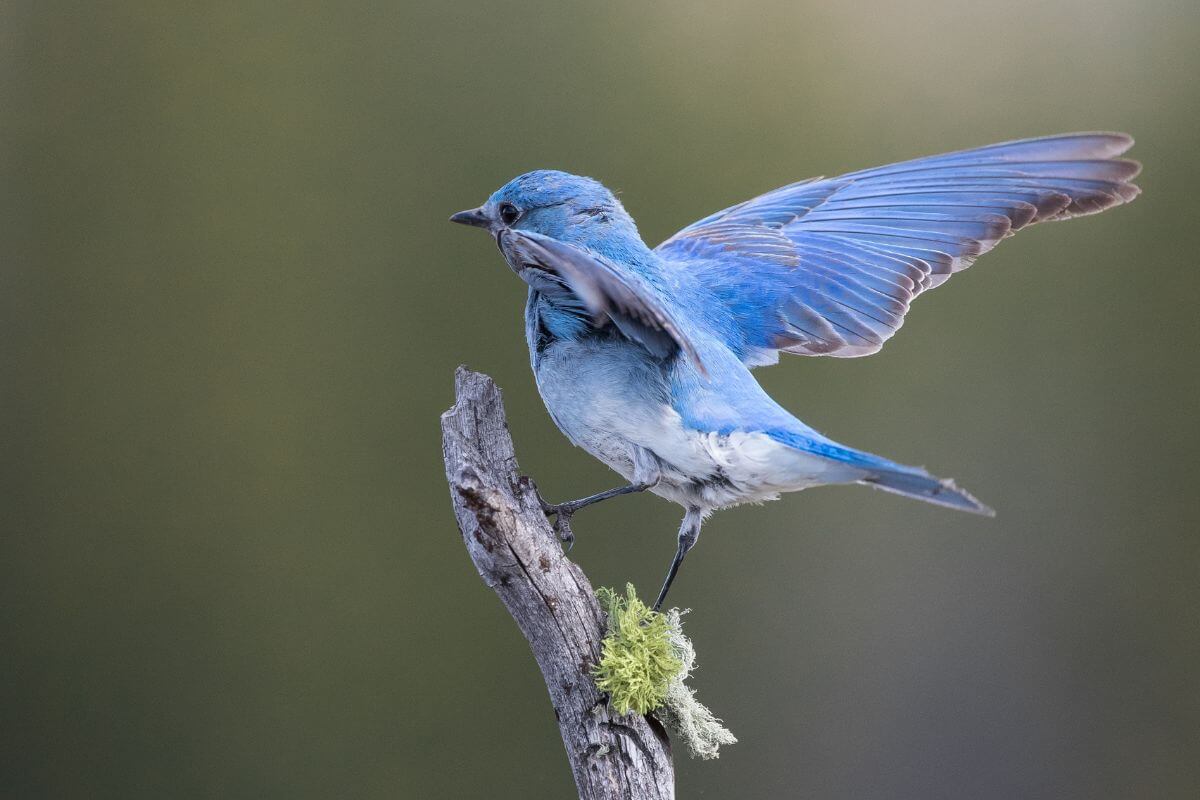
| Key Characteristics | Details |
|---|---|
| Scientific Name | Sialia currucoides |
| Family | Turdidae (Thrushes) |
| Habitat | Open woodlands |
| Food | Insects |
| Color | Sky-blue to gray-brown |
Mountain Bluebirds are common inhabitants of Montana’s open woodlands. They boast a striking sky-blue to gray-brown color. Their unique features include round heads, straight and thin bills, lanky bodies compared to other bluebirds, long wings, and extended tails.
Here are some interesting tidbits about Mountain Bluebirds:
- Mountain Bluebird males exhibit a nurturing trait by feeding their mates during the incubation and brooding periods.
- Mountain Bluebird nesting locations are fiercely contested as they compete with other cavity-nesting birds.
- Mountain Bluebirds are adaptable. They blend into human-influenced habitats, reside in specially designed bluebird boxes, and seek out meals in pastures.
Spotting Mountain Bluebirds is a delight as they often perch on exposed spots like treetops, fence posts, and power lines. Their beautiful songs complement their presence, adding melody to the natural Montana landscape.
24. Mountain Chickadee
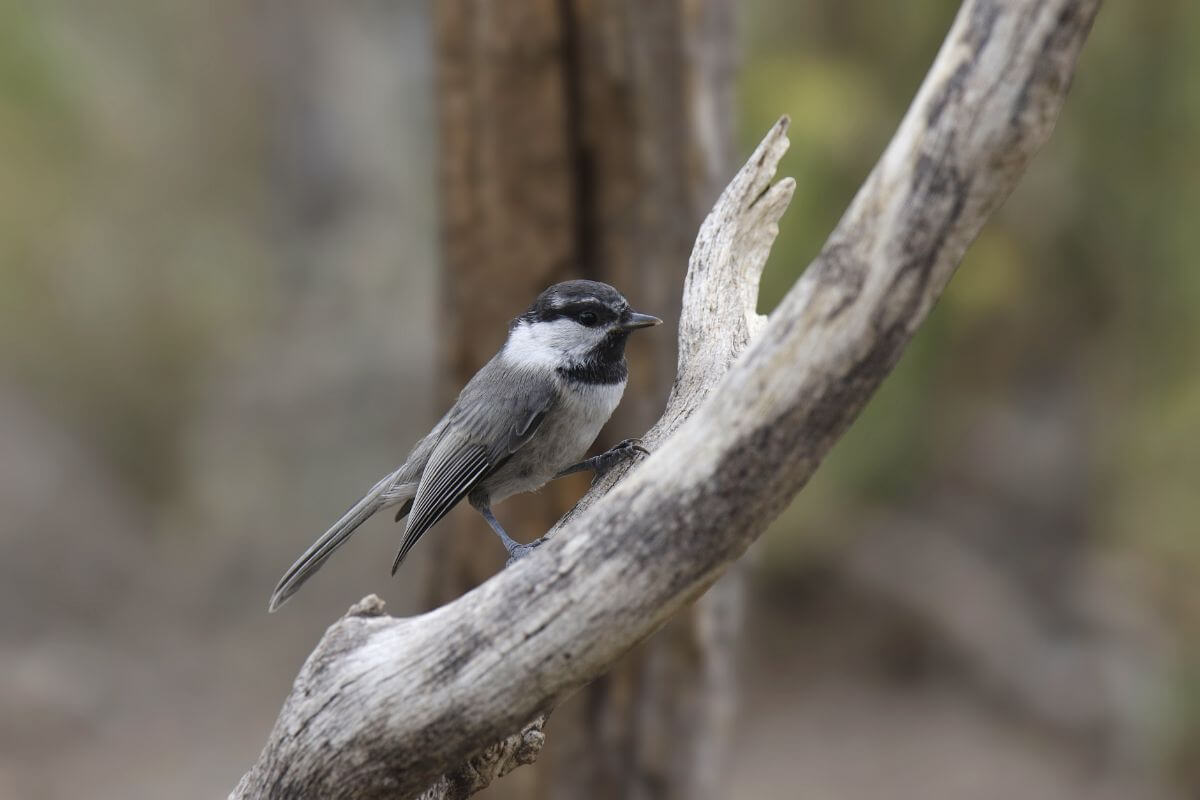
| Key Characteristics | Details |
|---|---|
| Scientific Name | Poecile gambeli |
| Family | Paridae (Chickadees) |
| Habitat | Montane coniferous forests |
| Food | Insects and conifer seeds |
| Color | Black-and-white on the head, gray elsewhere |
Mountain Chickadees are tiny yet bold and full of energy. They have large heads, slender tails, and quick, round wings. You can spot them flying through high tree branches and busily searching for insects and conifer seeds, often in mixed flocks with other small birds.
The Mountain Chickadee even have specific behaviors that make them unique:
- Mountain Chickadees work hard to stock up on food, especially when they find a good source like a bird feeder.
- During breeding, female Mountain Chickadees sit on their eggs for a week longer than their biologically similar cousins, the Black-Capped Chickadees.
- The Mountain Chickadees’ signature eye stripe is unique among chickadees, which sets them apart.
- Mountain Chickadees love to nest in cozy spots like tree cavities, nest boxes, or among tree roots. They build a cup nest of moss, lichen, and animal fur.
- Mountain Chickadees are unafraid to show off their acrobatic skills, hanging upside down from cones or twigs.
Watching the Mountain Chickadee is not just about their adorable appearance. It’s also about appreciating how they fit into their ecosystem, playing their part in spreading plant life through the seeds they eat and store.
25. Mourning Dove
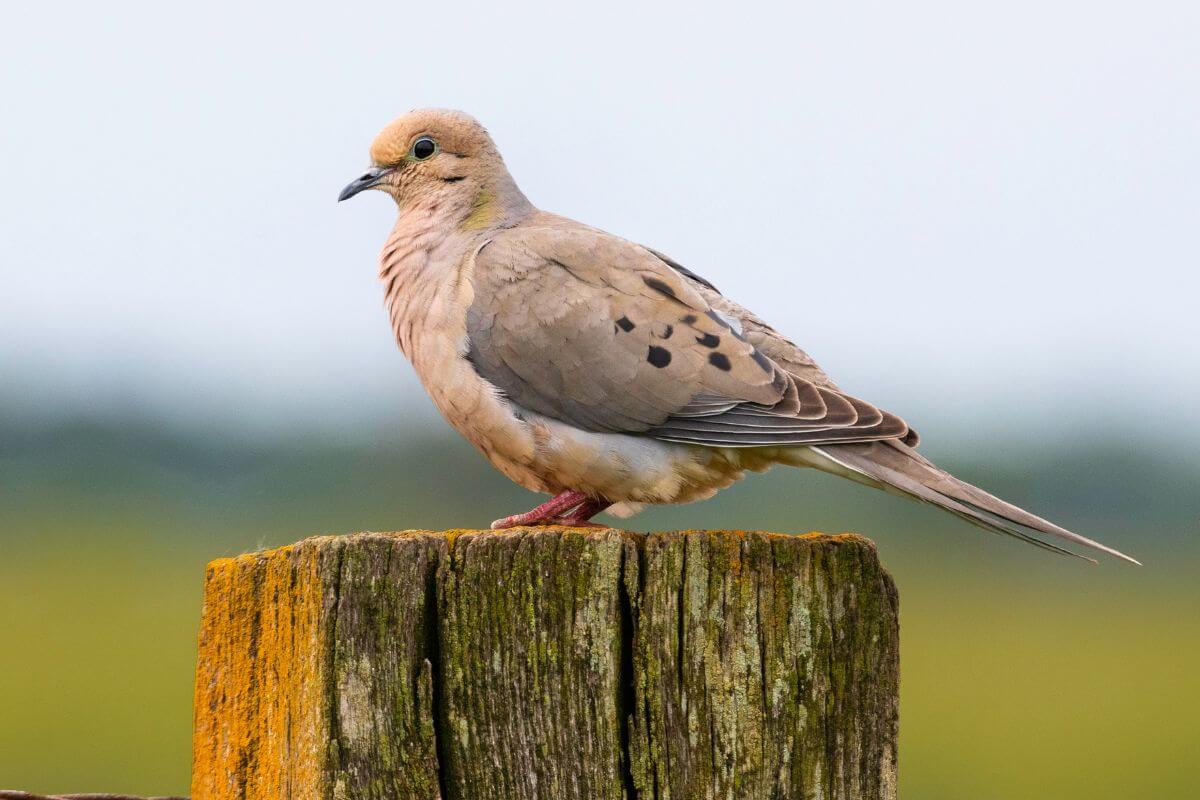
| Key Characteristics | Details |
|---|---|
| Scientific Name | Zenaida macroura |
| Family | Columbidae (Pigeon/Doves) |
| Habitat | Open woodlands |
| Food | Mostly seeds |
| Color | Delicate brown to buffy-tan overall |
The Mourning Dove is a graceful, slender-tailed bird commonly found across the continent, especially in the U.S. It is widely hunted, making it the most frequently targeted species in North America.
These doves’ plump bodies, lengthy tails, short legs, and small bills make them unique. The disproportion between their small head and robust body is notable, accentuating their slender elegance. In North American doves, their striking feature is the long and pointed tail.
Here are some interesting tidbits about the Mourning Dove that showcase their survival and adaptation skills:
- Mourning Doves have a unique ability to drink brackish spring water without the accompanying risk of dehydration, a trait that likely aids their survival in desert environments.
- Mourning Doves are a very abundant bird species in the United States. Their estimated population is around 350 million, and they continue to thrive despite over 20 million being harvested by hunters yearly.
Another distinct behavior of Mourning Doves is their preference for perching on telephone wires and scavenging for seeds on the ground. Their flight is remarkably swift and straight when they go into the sky. Their calls, often described as soft and drawn-out, resemble melodic laments.
26. Northern Flicker
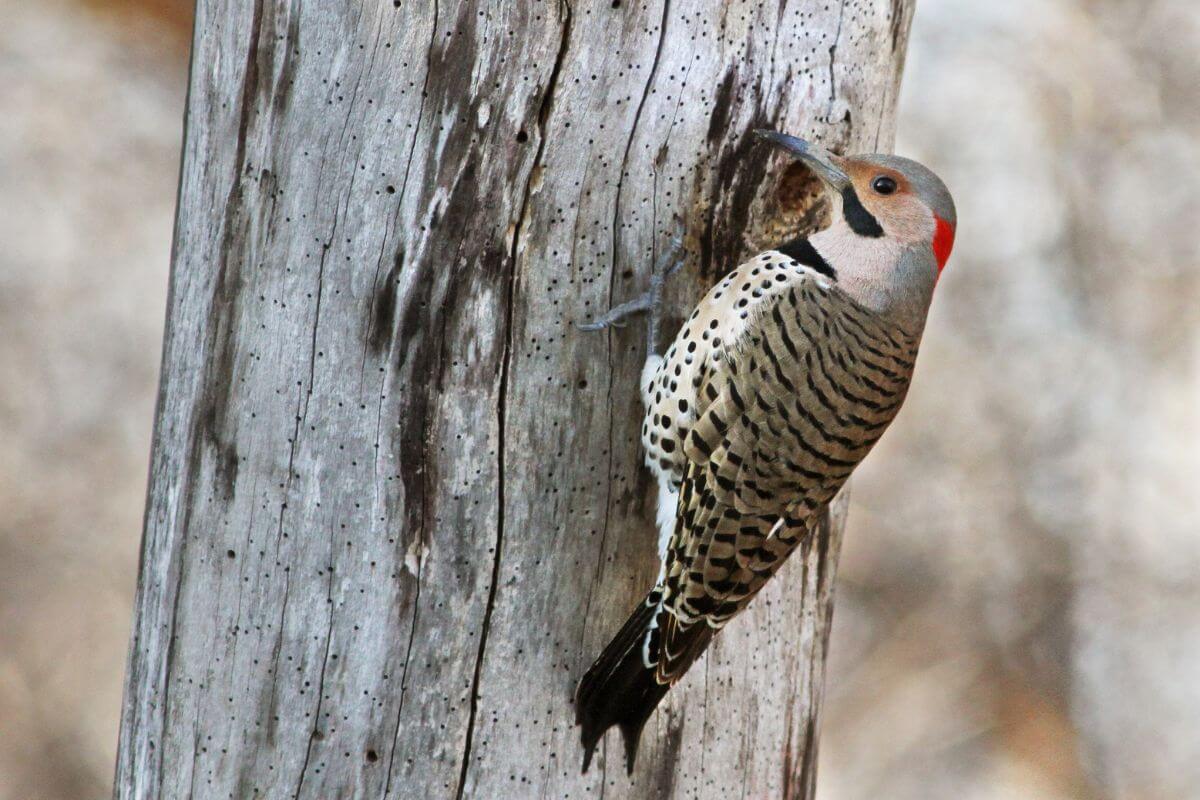
| Key Characteristics | Details |
|---|---|
| Scientific Name | Colaptes auratus |
| Family | Picidae (Woodpeckers) |
| Habitat | Forest edge and open woodlands |
| Food | Insects, primarily ants, and fruits and seeds |
| Color | Brownish overall with a white rump patch |
Northern Flickers stand out as big, friendly woodpeckers. What’s unique about them is their fancy black marks, spots, bars, and crescents. Their handsome plumage and gentle demeanor make bird watching a joy.
Here are a couple of impressive Northern Flicker facts:
- While Northern Flickers can peck away at trees, they’re more into pecking at the ground for snacks. It’s a bit of a twist for a woodpecker.
- Northern Flickers are among the few woodpeckers that make a long journey each year. They like to stretch their wings during migration.
- Northern Flickers display white rumps and a burst of color on their underwings during flight. This color is either bright yellow in birds from the eastern regions or reddish in flickers found west of the Rocky Mountains.
To spot a Northern Flicker, head to open woods or spots where forests give way. Check the ground, too, where they love to hunt. And it’s not just their looks that catch the eye. Listen for their loud call, a ringing cry, or a sharp yelp.
27. Pine Siskin
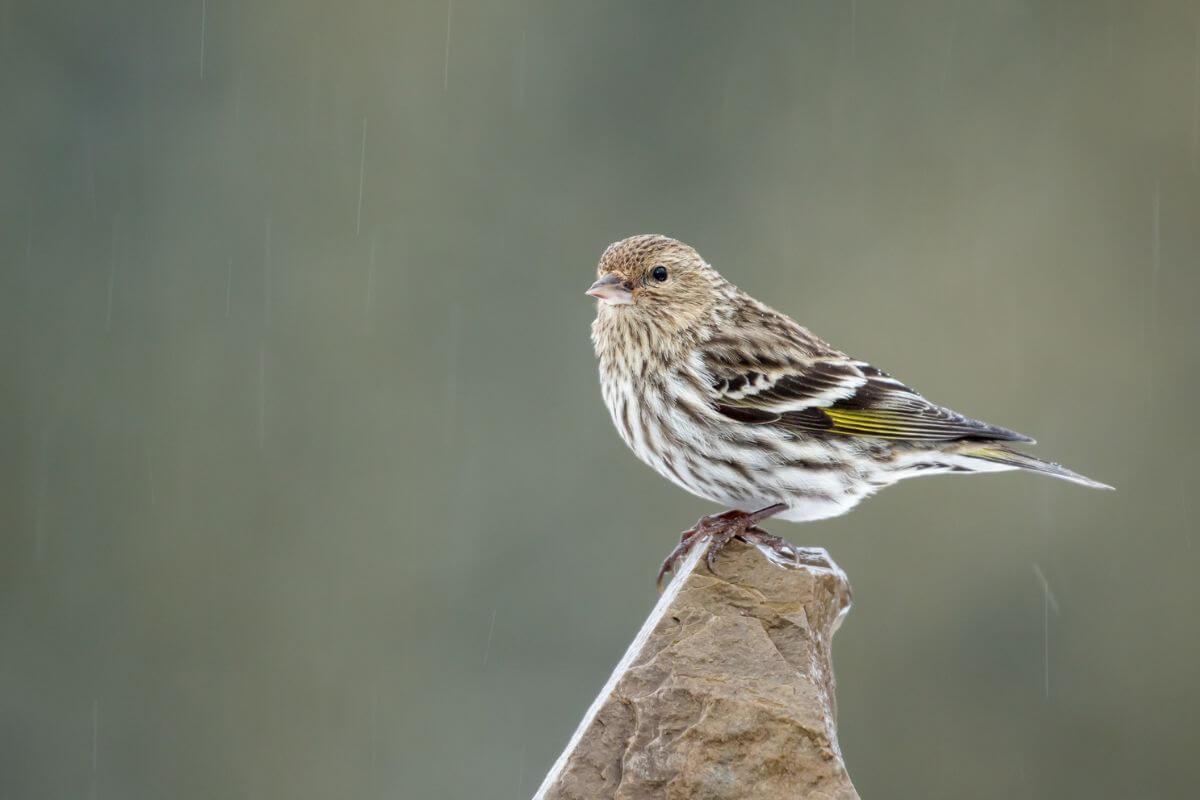
| Key Characteristics | Details |
|---|---|
| Scientific Name | Spinus pinus |
| Family | Fringillidae (Finches) |
| Habitat | Open woodlands |
| Food | Seeds |
| Color | Brown and very streaky birds |
The Pine Siskin is a delightful finch in the Fringillidae family. These brown and extremely streaky birds can be found in Montana’s open woodlands. If you see a flash of yellow on their wings, you’ve caught them mid-flutter or flight while showcasing their acrobatic nature.
Here are some tips to enhance your bird-watching experience:
- Watch Pine Siskins cling to the tips of branches, sometimes even upside down, as they feed on cones. They are better suited for branch tips than the ground.
- Pine Siskins are easily identified by their small size and highly streaked appearance, so keep a close eye on those feeders.
- Listen for the Pine Siskin’s special “watch-winding” call, a distinctive and memorable sound in their chatty flock exchanges.
Here are a few fun facts to share about the Pine Siskin:
- Pine Siskins are very social birds. They often travel and forage in close-knit flocks while constantly chattering.
- Pine Siskins don’t limit their feeding to woodlands. You might also find them in weedy fields, scrubby thickets, or even your own backyard.
- Pine Siskins’ nest-making skills are impressive. They craft cup-shaped homes from moss, lichens, grass, and other bits of vegetation.
Their flock twitters and acrobatic skills are a true delight to watch. Whether in a natural habitat or your own garden, the Pine Siskin brings joy to any bird-watching experience.
28. Red-Breasted Nuthatch
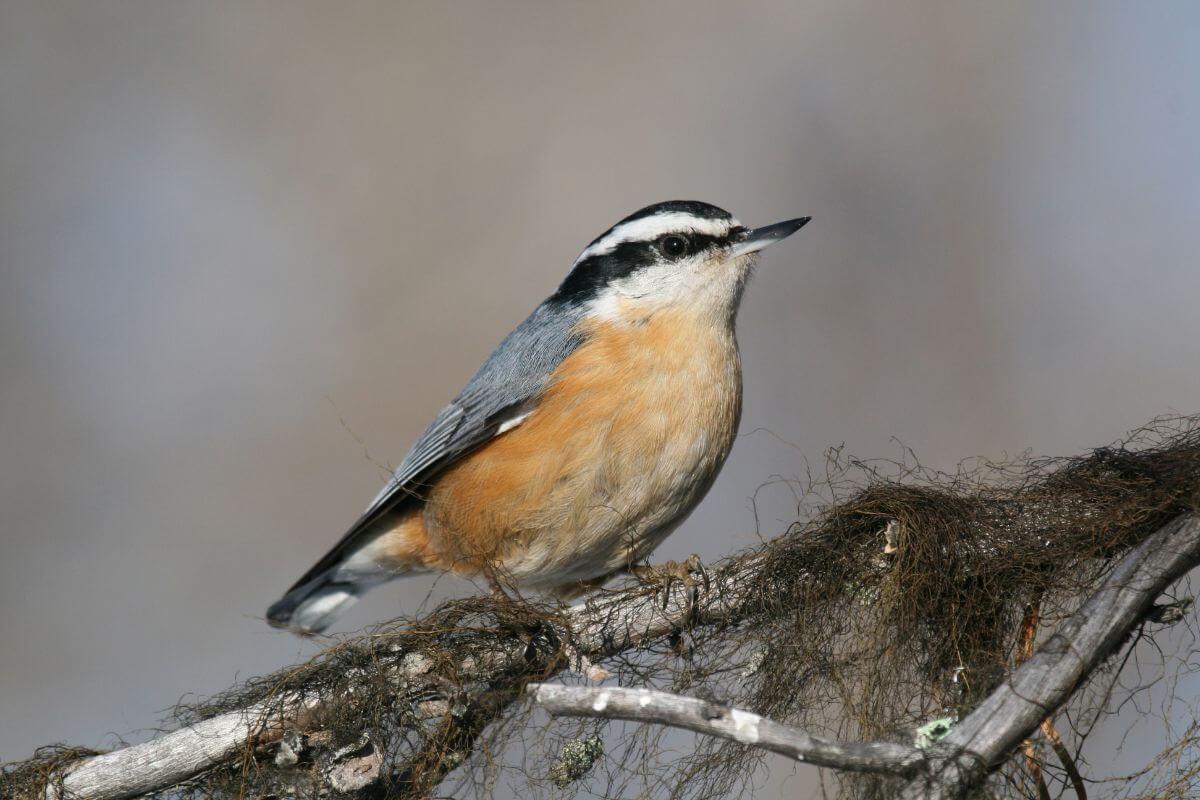
| Key Characteristics | Details |
|---|---|
| Scientific Name | Sitta canadensis |
| Family | Sittidae (Nuthatches) |
| Habitat | Forests with strong fir and spruce component |
| Food | Arboreal arthropods and conifer seeds |
| Color | Blue-gray birds |
You’ll be ecstatic once the Red-breasted Nuthatch flits into view. These blue-gray birds are active, especially around fir and spruce-filled woods. If you’re observing, you’ll see them zipping through canopies alongside chickadees, kinglets, and woodpeckers.
But they have a cute quirk. They prefer tree trunks and branches, scouring the crevices for insects while letting out high-pitched “yank-yank” calls. It’s like listening to tin horns buzz gently in the tree crowns.
Here are a few gripping tidbits about the Red-Breasted Nuthatch:
- Red-breasted Nuthatches can get a bit cheeky, stealing nest-lining material from nests that are not theirs. They sometimes swipe from their smaller cousins, the Pygmy Nuthatches and Mountain Chickadees.
- During the nest-building season, Red-breasted Nuthatches ramp up their game by turning territorial and chasing away fellow hole-nesting birds to protect their patch.
The Red-breasted Nuthatch is a small, short-tailed bird that deserves a special place in your heart and a keen eye on your feeder.
29. Red-Tailed Hawk
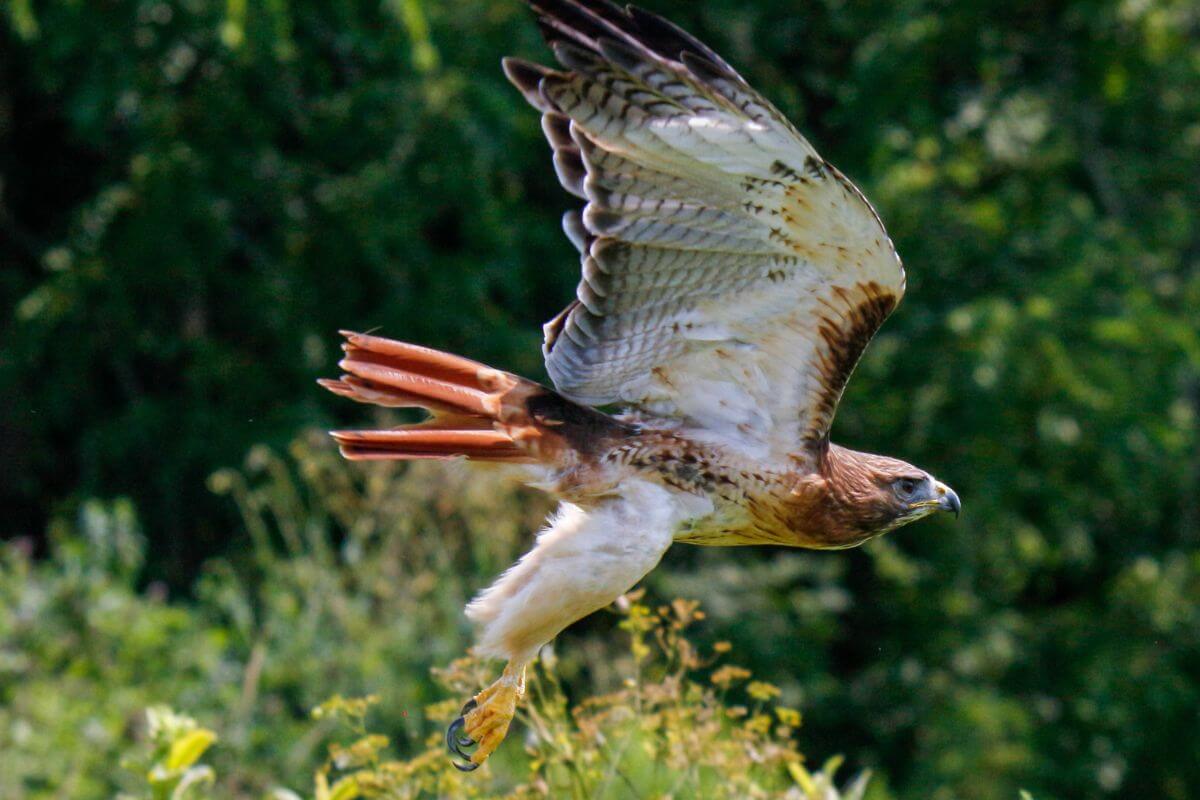
| Key Characteristics | Details |
|---|---|
| Scientific Name | Buteo jamaicensis |
| Family | Accipitridae (Hawks/Kites/Eagles) |
| Habitat | Trees and on cliffs |
| Food | Ground squirrels and other small rodents |
| Color | Rich brown above and pale below |
Driving through Montana, you’re bound to spot the Red-tailed Hawk. Here are some tips to make sure you catch a glimpse of these aerial acrobats:
- Keep an eye out along fences and in the sky while you’re on a drive. Red-tailed hawks are commonly seen in open fields, where they soar gracefully.
- Look at its size to recognize a Red-tailed hawk. Although they’re among the largest birds in North America, even the big females weigh only around 3 pounds.
- Listen for the Red-tailed hawks’ unique raptor-like screech.
If you’re lucky, you might witness a Red-tail hawk courting ritual. The hawks fly high and fast in this ritual, showcasing their aerial acrobatics.
Seeing a Red-tailed Hawk is a special Montana experience. They add to the beauty of our skies with their elegant soaring and might just greet you with their loud, thrilling screech.
30. Red-Winged Blackbird
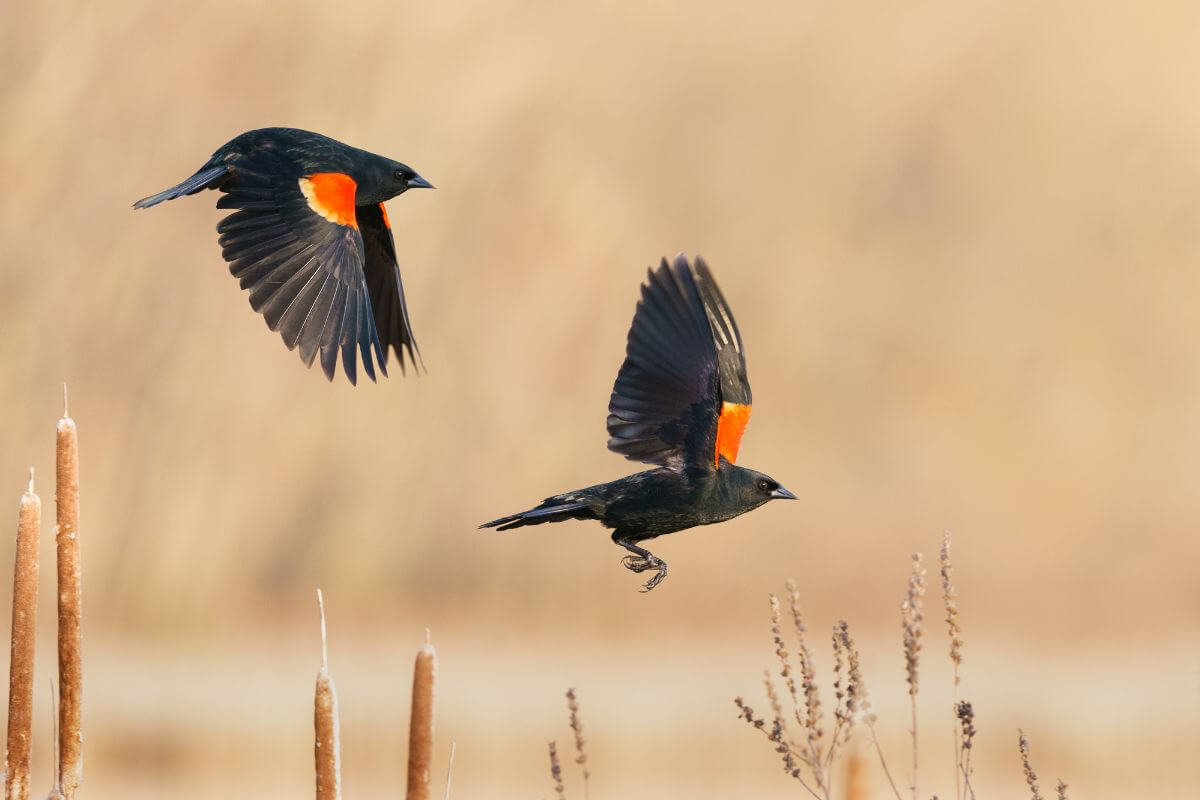
| Key Characteristics | Details |
|---|---|
| Scientific Name | Agelaius phoeniceus |
| Family | Icteridae (Blackbirds) |
| Habitat | Wetland and upland habitats |
| Food | Plant and animal matter |
| Color | Glossy black with red-and-yellow shoulder badges |
One of the most common birds in North America, the Red-Winged Blackbird stands out with its shiny black plumage and eye-catching red-and-yellow patches on its wings. You can easily spot them in cattail marshes and wetlands, and they are even perched on telephone wires along country roads.
Here are some interesting facts about Red-winged blackbirds:
- Red-winged blackbirds’ joyful sound and their early and unsteady melody signal the arrival of spring. The male has a distinctive “conk-la-lee” song.
- Male Red-winged blackbirds are unique in their social behavior. They are what’s called polygynous, which means one male has many female mates, sometimes even up to 15!
- Male Red-winged blackbirds fiercely defend their territories during the breeding season, devoting more than a quarter of their daylight to ensure no interlopers disrupt their households.
If you’re birdwatching during the breeding season, look for these guys. They are so abundant that they are almost guaranteed to be part of your experience.
31. Ring-Billed Gull
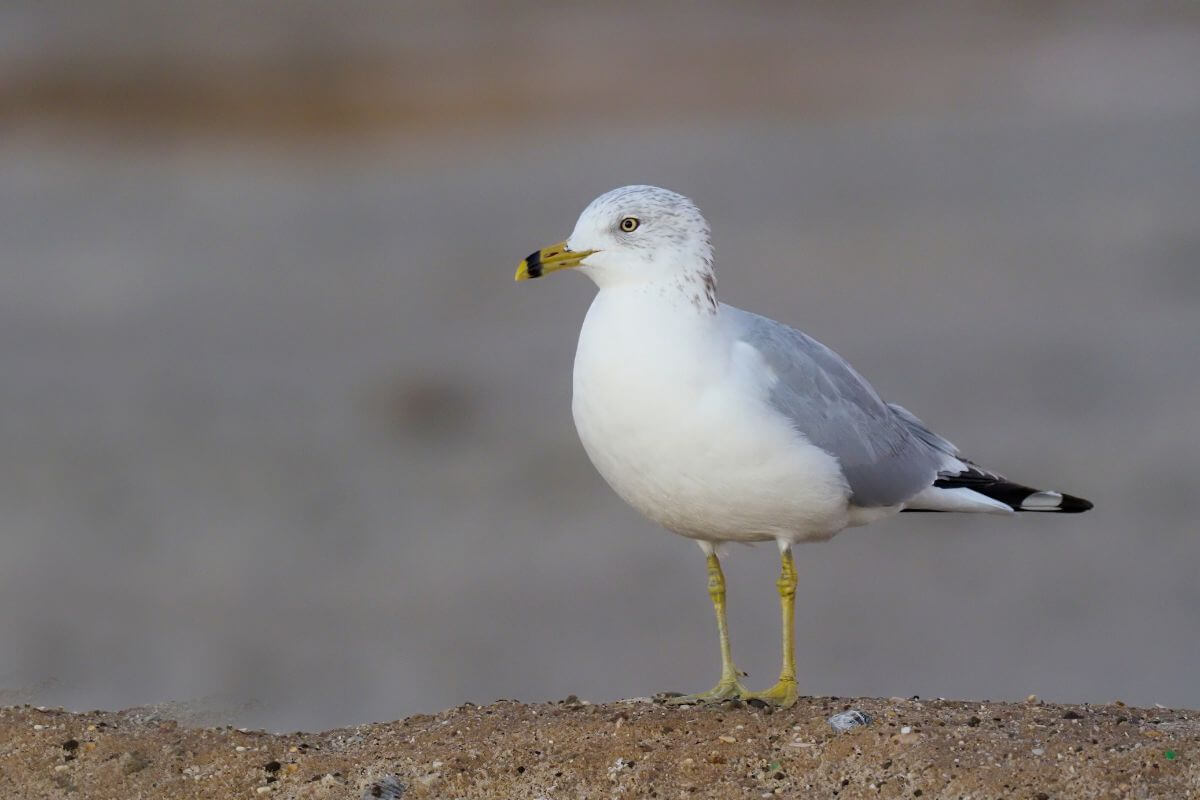
| Key Characteristics | Details |
|---|---|
| Scientific Name | Larus delawarensis |
| Family | Laridae (Gulls/Terns) |
| Habitat | Freshwater |
| Food | Fish, insects, earthworms, rodents, and grain |
| Color | Clean gray above, with a white head, body, and tail |
The Ring-billed gull is a medium-sized gull with a fairly short, slim bill. One key identifying feature is its long and slender wings extending notably past its square-tipped tail when perched.
Here are some fascinating details about the Ring-billed gull:
- Ring-billed gulls are quite comfortable around humans. They appear in various urban and rural spots like parking lots, garbage dumps, beaches, and fields, sometimes in large numbers.
- Nesting colonies of Ring-billed gulls can sometimes feature a few two-female couples, showcasing diverse social structures.
- Ring-billed gulls exhibit impressive navigation skills during migration. They use a combination of an innate compass, landmarks, and high-altitude winds to guide their way.
- Juvenile Ring-billed gulls are a mix of brown and gray with a pink bill and legs, gradually changing as they mature.
- Ring-billed gulls breed in colonies, often choosing island locations and creating shallow stick nests on the ground.
These gulls hang out in various spots, from parking lots to sporting events. You can also spot them in more natural habitats like reservoirs, lakes, marshes, mudflats, and beaches. From urban areas to more remote environments, their adaptability to habitat choices offers a great opportunity to observe them.
32. Rock Pigeon
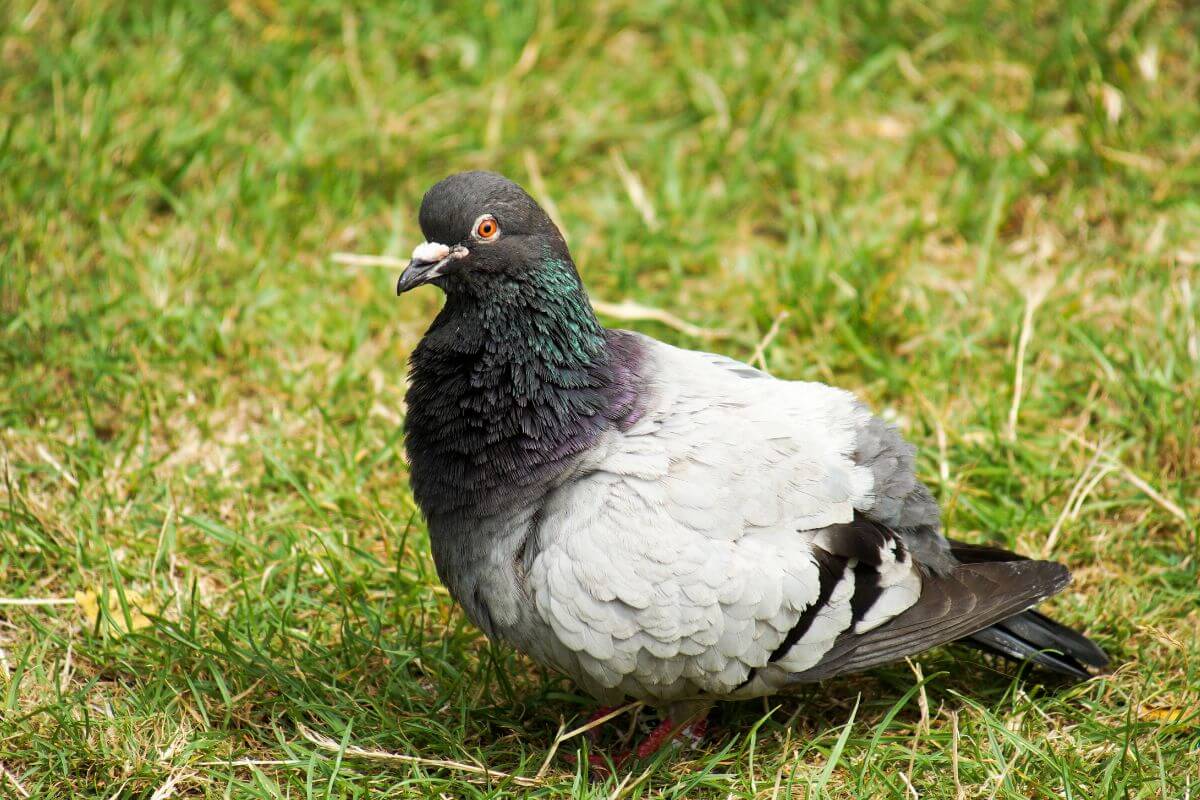
| Key Characteristics | Details |
|---|---|
| Scientific Name | Columba livia |
| Family | Columbidae (Pigeon/Doves) |
| Habitat | Cities and towns or farms with livestock |
| Food | Seeds, fruits, and invertebrates (rarely) |
| Color | Variable in color, but most birds are bluish-gray |
Rock Pigeons are a common sight in cities and towns around the globe. These birds are often found in urban parks, neighborhoods, and areas with farms and livestock. You can spot them under highway or railroad bridges and around tall rocky cliffs.
Here are some cool facts about Rock Pigeons:
- Rock Pigeons can find their way home even when released from a far-off location with their vision blocked.
- The ancient Mesopotamians and Egyptians domesticated Rock pigeons over 5,000 years back, as seen in cuneiform tablets and hieroglyphics.
- During World Wars I and II, Rock Pigeons served crucial roles in the U.S. Army Signal Corps by carrying messages, saving lives, and providing key intelligence.
- Resourceful Rock Pigeons make their homes using sticks and other ledge-adjacent materials. They create shallow nests on both natural and human-made structures.
Although often overlooked due to their commonality, Rock Pigeons have a deep history intertwined with human society. Watching these birds in cities or considering their place in history provides valuable insights into their remarkable abilities and significance.
33. Song Sparrow
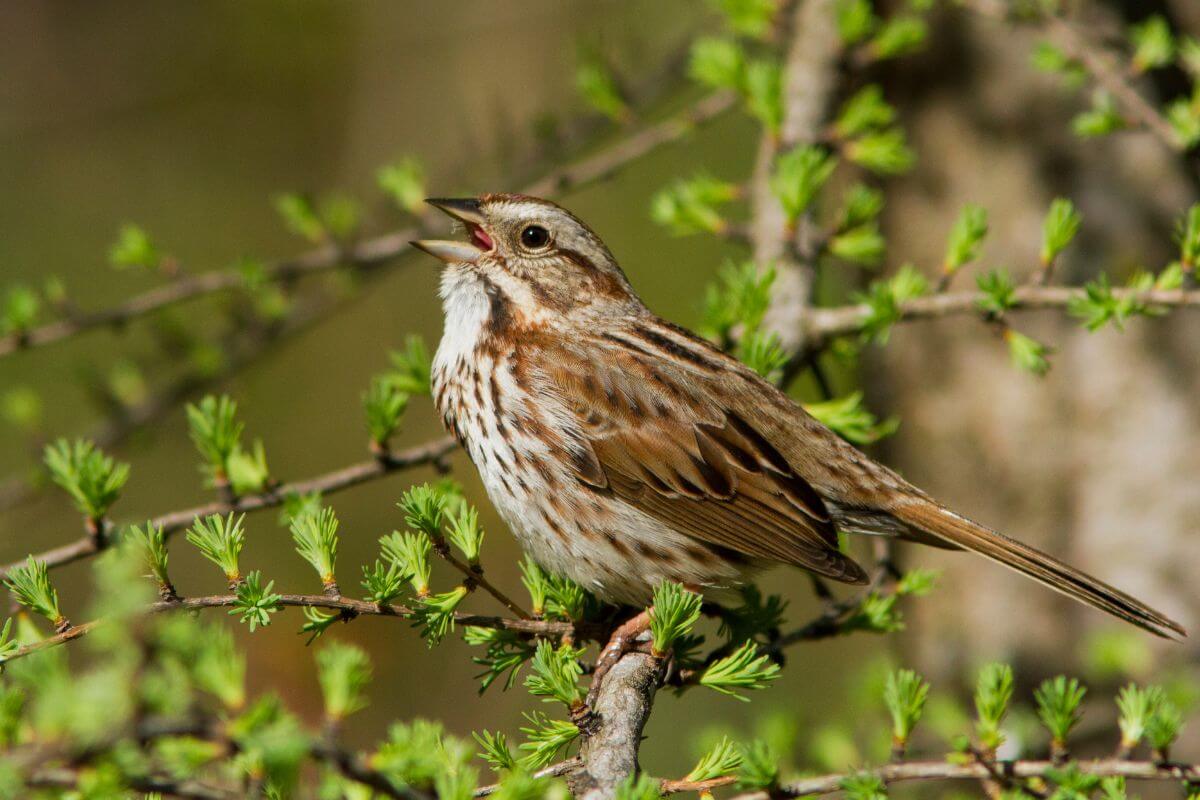
| Key Characteristics | Details |
|---|---|
| Scientific Name | Melospiza melodia |
| Family | Passerellidae (New World Sparrows) |
| Habitat | Wide range of forest, shrub, riparian, and brushy habitats |
| Food | Seeds, fruits, and invertebrates |
| Color | Streaky and brown with a thick dark mark on each side of its white throat |
The Song Sparrow is one of the most well-known and abundant species among North American sparrows. It is easily recognized by its rich russet and gray plumage and bold streaks running down its white chest.
During the mating season in spring and summer, male Song Sparrows become quite prominent. You’ll frequently spot them singing loudly from exposed branches, seeking mates and defending their territory at eye level.
Here are some fascinating tidbits about Song Sparrows that shed light on their behavior and characteristics:
- Song Sparrows have an innate ability to understand what makes a good nest.
- Song Sparrow flights are distinctive — a quick, fluttering motion with an evident downward tail pumping.
- Song sparrows have around 24 recognized subspecies and about 52 described forms, making them one of the most diverse birds in North America regarding regional variation.
- You’ll often find Song Sparrow nests in dense shrubbery, low trees, or areas close to water, reflecting their affinity for specific nesting environments.
These ground-dwelling birds’ unique voices and body features make them important to the North American ecosystem.
34. Spotted Towhee
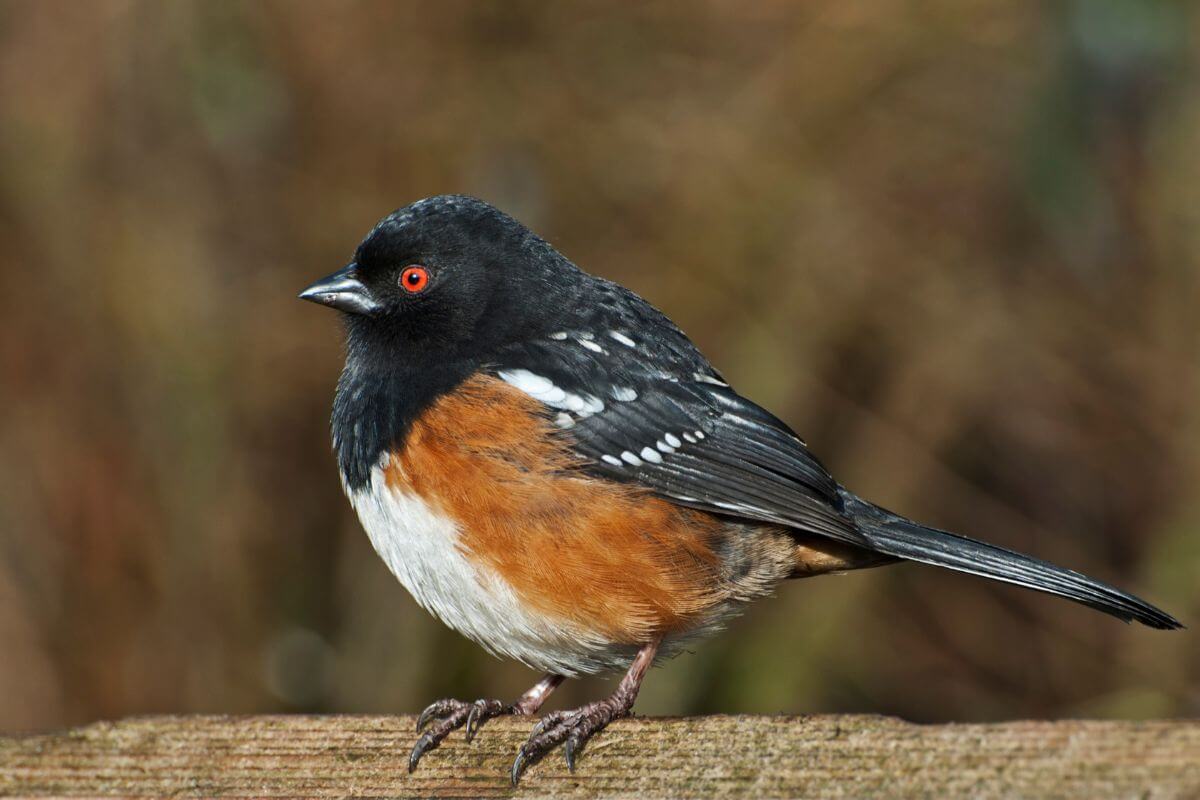
| Key Characteristics | Details |
|---|---|
| Scientific Name | Pipilo maculatus |
| Family | Passerellidae (New World Sparrows) |
| Habitat | Scrub |
| Food | beetles, spiders, and other arthropods |
| Color | Jet-black upperparts and throat |
The Spotted Towhee is a large sparrow commonly seen in sunny areas of the West. Its shiny black back and throat, marked with white specks and stripes, make it easy to spot. Female towhees have a more subtle gray-brown color.
Here are a couple of intriguing bits and pieces about the Spotted Towhee:
- Male Spotted Towhees are up at the crack of dawn in the early days of the breeding season, singing their hearts out to impress potential partners.
- A unique two-footed, backward-hopping move characterizes the Spotted Towhee’s feeding routine. Called “double-scratching,” this fascinating dance is used by towhee and sparrow varieties to unearth the seeds and tiny critters they love to eat.
If you’re about to discover this bird, slowly edge along the forests, thickets, and tangled fields. Listen for its distinct whiny, cat-like mew call or its lively song. You might even catch it by its rustling sounds in the dry leaves.
35. Western Bluebird
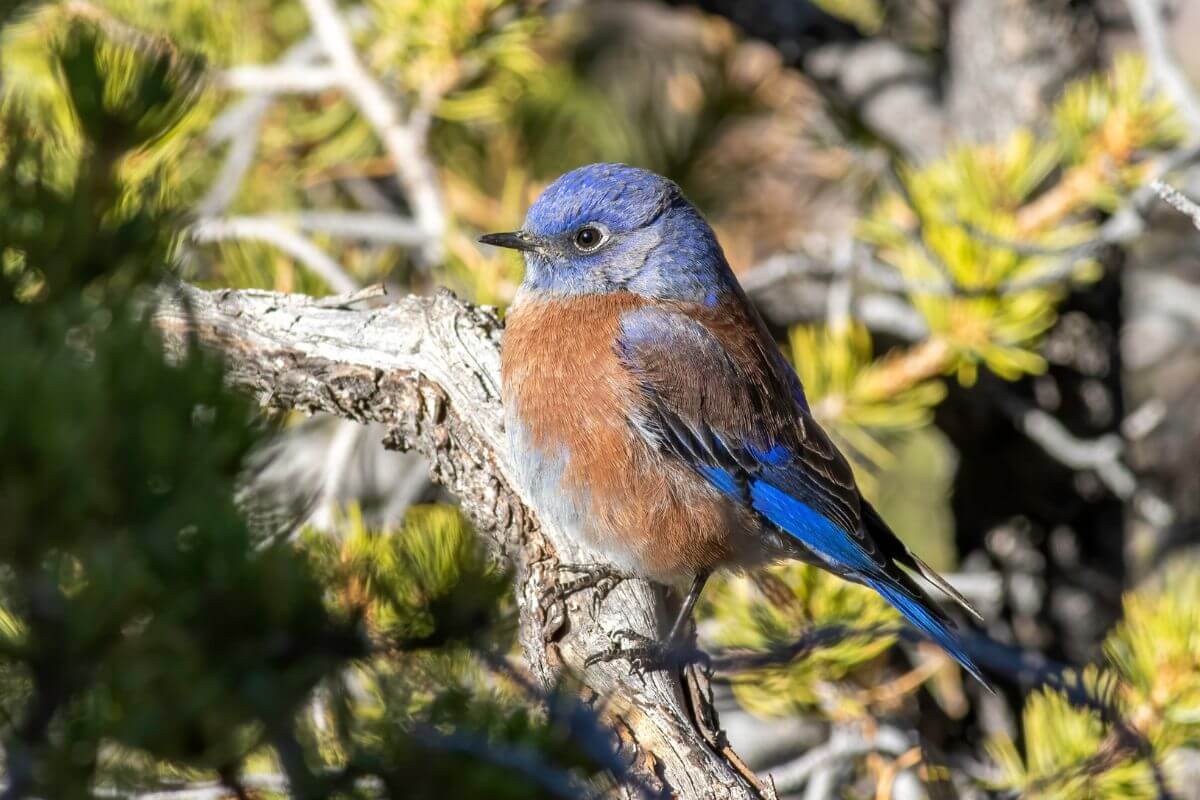
| Key Characteristics | Details |
|---|---|
| Scientific Name | Sialia mexicana |
| Family | Turdidae (Thrushes) |
| Habitat | Open coniferous and deciduous woodlands |
| Food | Insects, berries, and fruits |
| Color | Shiny blue with rust-orange |
Western Bluebirds are small and common thrushes that often sit upright and have stocky bodies. They also have thin beaks and short tails. During summer, you can spot them on low perches in woodlands, at the edges of wooded areas, or perched on nest boxes or fence posts.
Here are some intriguing insights about Western Bluebirds:
- Despite their gentle appearance, territorial disputes among Western Bluebird males can lead to intense physical altercations.
- One unique Western Bluebird behavior that might catch your eye is sudden drops to the ground during hunts.
- Western Bluebirds rely on nesting cavities, but their beaks aren’t designed for excavation. They depend on woodpeckers to create these essential spaces for nesting.
Their shiny blue feathers with rust-orange accents make them stand out. While their call notes are subtle, they’re quite distinct once you’ve learned to recognize them. They might sound quiet and inquisitive, contrasting with moments of territorial disputes where rival males fiercely battle.
36. Western Meadowlark
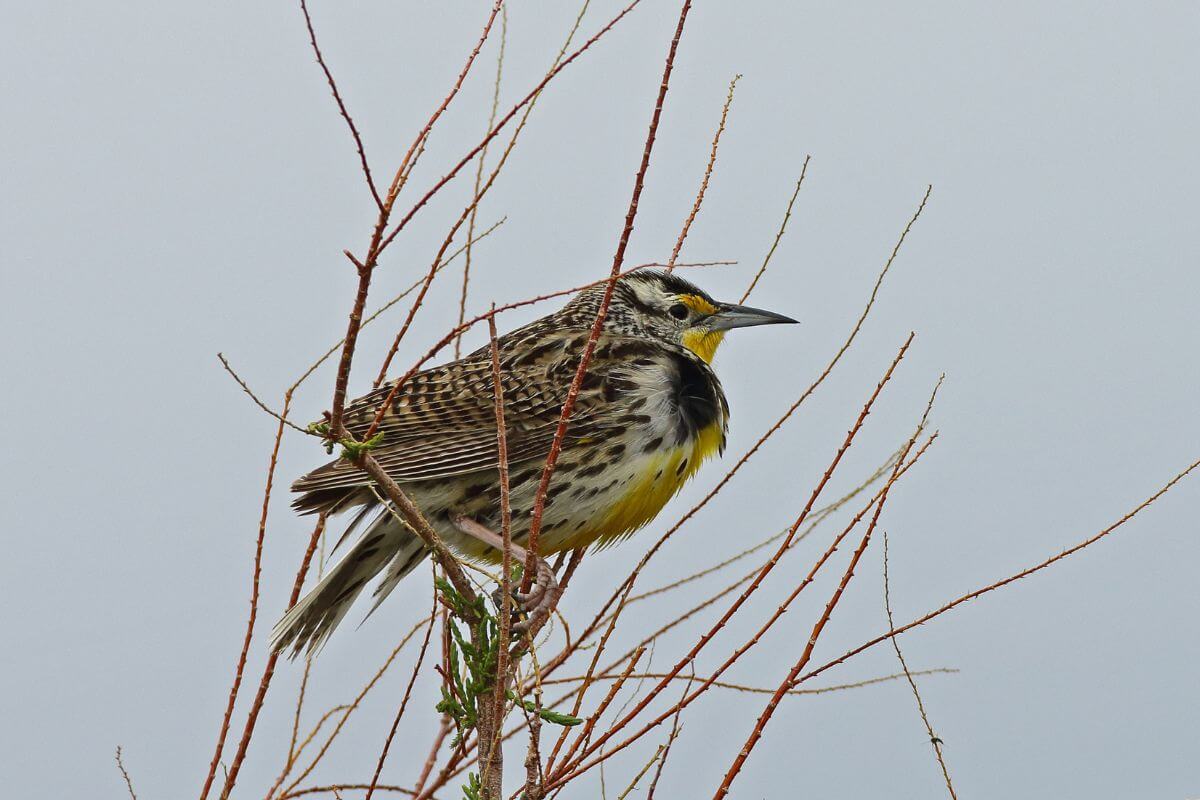
| Key Characteristics | Details |
|---|---|
| Scientific Name | Sturnella neglecta |
| Family | Icteridae (Blackbirds) |
| Habitat | Native grasslands and pastures |
| Food | Grain, weed seeds, and insects |
| Color | Yellow underparts with brown, black, and buff upperparts |
The Western Meadowlark, Montana’s state bird, is a vibrant sight with its yellow breast adorned by a bold, black, V-shaped band. About the size of a robin but chunkier, it’s easily recognized by its flat head, long, slender bill, and compact shape that hides its neck.
Here are some cool things about the Western Meadowlark:
- Western Meadowlark nests are unique, often hidden under a cozy grass roof.
- In 1805, explorer Meriwether Lewis played a big part in recognizing the differences between the Eastern and Western Meadowlarks.
- The Western Meadowlark isn’t just a Montanan favorite — it’s also the official state bird for 5 other states.
- The Western Meadowlark is quite the charmer, with a male often having two mates simultaneously.
When you’re out looking for one, keep in mind that these meadowlarks are usually heard before they’re seen. They have a unique and cheerful song that consists of a loud and clear warble, usually performed by males from fence posts. This, along with their bright yellow throat and interesting lifestyle, makes the Western Meadowlark a fascinating bird to spot in Montana.
37. Yellow Warbler
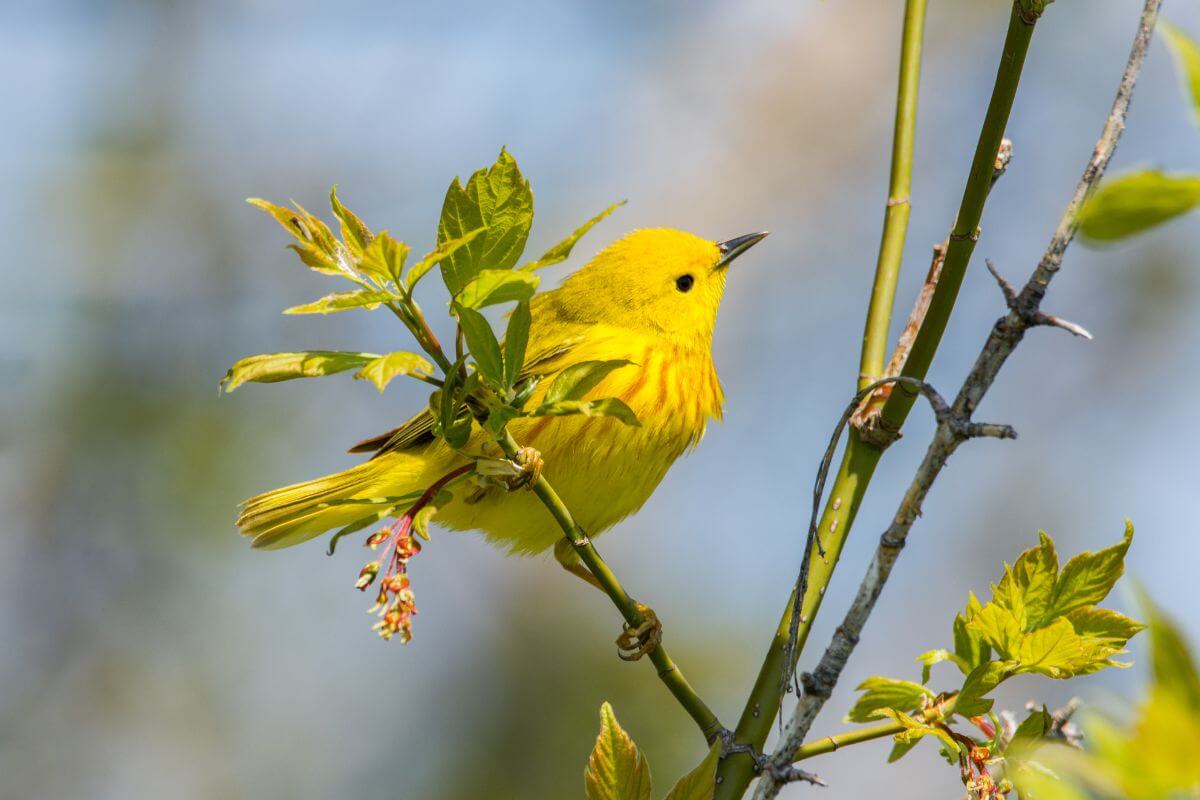
| Key Characteristics | Details |
|---|---|
| Scientific Name | Setophaga petechia |
| Family | Parulidae (Warblers) |
| Habitat | Wet, deciduous thickets |
| Food | Insects and other arthropods |
| Color | Yellow birds |
You can easily recognize a Yellow Warbler by its small size, sharp beak, and bright yellow plumage. Both male and female Yellow Warblers sport a yellow color with olive-yellow upperparts and two yellow wing bars.
During the breeding season, male Yellow Warblers showcase a brighter yellow color with chestnut streaks underneath. In contrast, females and young ones are duller and lack the streaks. All of them have little yellow spots on their tails.
Here are some fun facts about the Yellow Warbler that add to their charm:
- Yellow Warbler nests are often targeted by parasitic Brown-headed Cowbirds.
- There have been rare instances of Yellow Warblers getting caught in an orb weaver spider’s web.
- Yellow Warblers are resourceful when it comes to nesting. They use grass, bark strips, and plant fibers to create a deep cup nest, typically in bushes or small trees.
- Yellow Warblers typically search for insects among the branches and leaves of bushes and trees, usually in edge habitats.
This bird has a pretty sweet song, literally. Listen for them in wet woods, thickets, or streamsides. They are among the most commonly heard warblers during spring and summer. Their song is a cascading set of whistles that sounds like “sweet, sweet, I’m so sweet.”
Common Montana Birds Final Thoughts
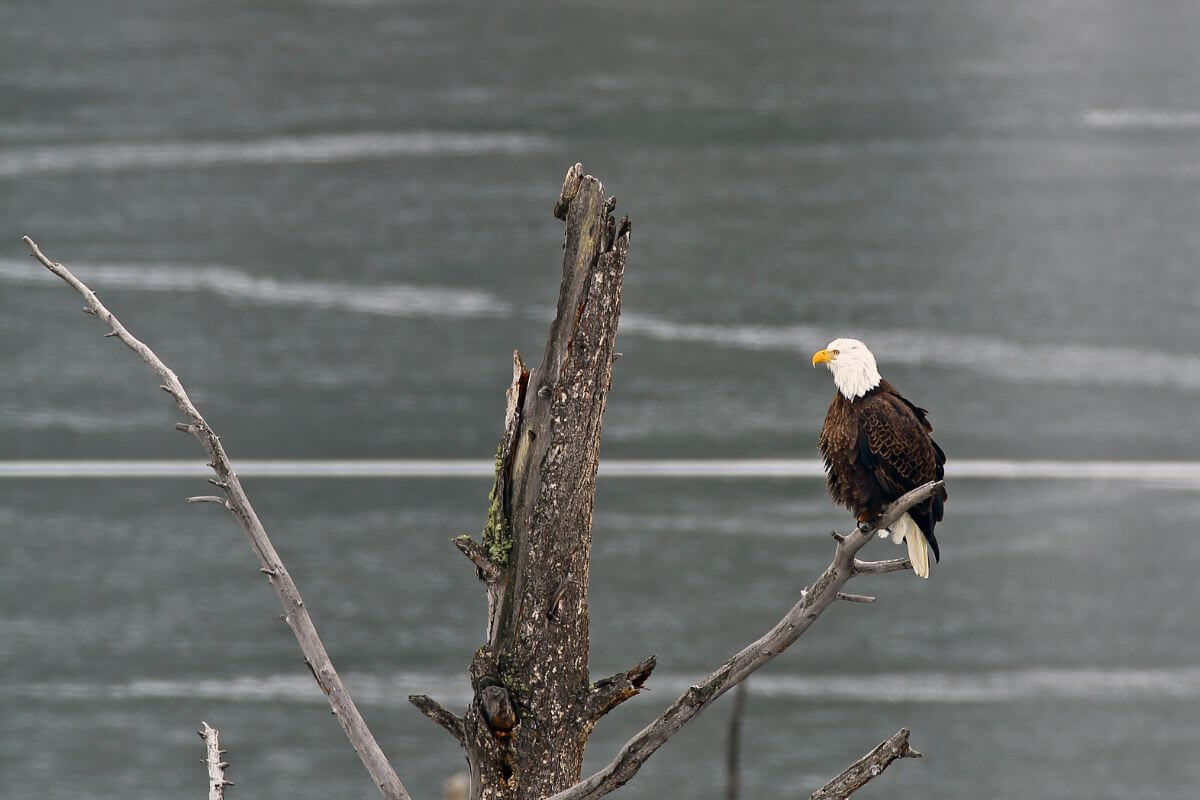
Montana’s skies host a variety of birds, attracting both beginner watchers and expert enthusiasts. The state’s diverse landscapes provide a habitat for many common birds.
From the majestic Bald Eagle to the sociable American Goldfinch, each bird contributes to Montana’s vibrant wildlife scene. These birds enhance Montana’s natural beauty and play essential roles in the ecosystem.
So, when you’re in Montana, remember to look up and appreciate these magnificent birds.
Montana Bird Guide FAQs
1. How Many Birds Are in Montana?
Montana boasts a diverse avian population, with 424 bird species recorded. Among these, 156 species overwinter within the state, while an additional 44 species, which typically do not overwinter, have been observed during winter months, showcasing the state’s significance as a habitat for a wide range of birds.
2. Do Storks Live in Montana?
Storks, particularly the Wood Stork, are not native to Montana. However, the Wood Stork was recorded in the state twice during the early 20th century, making it an accidental species with only rare occurrences in Montana’s avian history.
3. When Was Montana’s State Bird Adopted?
Montana adopted the Western Meadowlark as its state bird in 1931. This decision was influenced by the enthusiastic response of the state’s school children in 1930, who widely recognized the meadowlark as the bird that best represented Montana’s natural heritage.
4. What Is the Big White Bird in Montana?
The large white bird commonly observed in Montana is the American White Pelican. Identified by its impressive wingspan and distinctive black trailing edges on its wings during flight, the American White Pelican also features a prominent yellow-orange bill that curves downward when perched or swimming.
5. What Bird Represents Montana?
The state of Montana is represented by the Western Meadowlark as its avian symbol. Montana’s school children picked this particular bird in 1930, owing to its melodious song and abundance in the grasslands. The Western Meadowlark, therefore, serves as a perfect embodiment of Montana’s natural heritage and spirit.
Dive into our collection of captivating articles about Montana:

